#the bill: writer: maxwell young
Explore tagged Tumblr posts
Text
15.44 Taxed






















Smithy arrives at Sun Hill and Luke immediately earns his disdain by losing his bottle and then lying about it. It’s a strong first episode for Smithy, and it says a lot that he quickly finds a place in the relief, while Luke’s still reliant on Tony. And, as abrasive as Smithy is, he’s got a point. When you’re in a dangerous situation, you don’t want someone failing to back you up because they’re scared.
My memory of Smithy is as s Steve 2.0 (and of my old housemate having a massive thing for him) so it’ll be interesting seeing how that memory holds up.
I don’t like Luke, so I really couldn’t be arsed doing anything more with the ghastly colouring and lighting in this episode ;p
#the bill#cass rickman#dale smith#luke ashton#bob cryer#sam harker#tony stamp#dave quinnan#tb: taxed#the bill: series 15#the bill: 1999#the bill: writer: maxwell young#the bill: first episode
6 notes
·
View notes
Text
I just really think Remus Lupin is a ballerina okay AU
Remus Lupin has been doing ballet since he was four. He was exuberant and flashy at first, but after his first teacher, Greyback, molested and abused him, he is quiet and reserved. He prefers to dance by himself and does not speak to anyone inside or outside of the class. He wears pink material and is the best dancer in the school, but everyone is more terrified of him than they are jealous. He has sad eyes and soft hair, but prominent scars (both self-inflicted and from Greyback and accidents) cover his freckled skin. He’s a mystery, but no one wants to solve him.
He lives with his roommate and only friend, Severus Snape, who is a writer. He spins out films and novels and poems by the hundreds, especially inspired by the rain. Remus and Severus will often spend rainy days together in their apartment, with Severus typing furiously and scribbling while Remus dances to Hozier and Lana Del Rey off to the side. Sometimes when Remus will have nightmares, Severus will hold him and sing Russian lullabies until he falls asleep. Severus smokes lazily and wears subdued flower and gothic dresses that show off his jutting hips and collar bones. Having escaped an abusive father and a dead mother, he and Remus bond over their shit parents, with Remus’ father being neglectful and his mother kind but catatonic. Their neighbors think they’re witches, but they’re alright with that.
They both have to work to pay the bills, so while Severus works with preschoolers, Remus works as an assistant for a terrifying professor named Grindelwald at the university. He’s a reformed felon who’s always glowering, and there are rumors he’s Dumbledore’s husband, who is Remus’ mysterious ballet teacher with the twinkling eyes. But no one has the guts to ask him - it’s unknown what he was locked up for, and nobody wants to risk that it was irrational homicide. He mostly ignores Remus though, and doesn’t mind if Remus reads or dances while he works, so Remus doesn’t think he’s too bad.
One day Remus is grading some papers for Grindelwald when Lily Evans walks in, a vision in a white floral lace flowing vest and an across-the-shoulders dark blue dress, a brown belt around her waist and matching ankle boots coming up over creme knee-high knit socks, a black hat on her head. There’s a camera around her neck and her smile is beautiful, surrounded by her freckles, and she and Remus hit it off immediately. She asks if he can spare some time to be her model for the day, and he agrees. They’re hanging out in the park and laughing when Severus walks over, having finished work. The moment he and Lily lay eyes on each other, something happens, something magical, and Remus can see it in both of their smiles as they exchange shy hellos.
Lily starts to hang around them, her and Severus teetering on the edge of something. Remus nudges Severus until he’s brave enough to ask her out, and their first date is in the park where they met, sitting on a bench in the rain and watching the birds. Remus is pretty sure they’re gonna get married one day.
To keep himself busy while his two friends fall in love, Remus escapes to the dance school, dancing alone to Lana Del Rey in an empty room when the door creaks open and he hears, “Wow.” He turns around and smiles, taking in the sight of James Potter, an old school friend who left for Julliard and he hasn’t seen in years. James laughs, pulling him into a hug, and Remus lets him, tangling his hands in James’ curls and grinning when James presses a kiss to the corner of his mouth. James tells him he’s been enjoying a gap year before going to search for a job as a back-up dancer for Taylor Swift, to which Remus giggles and tells him he’ll be great. James beams, and pulls Remus along, saying he has to meet James’ best friend-partner-person. Remus agrees, and changes back into his flowing white dress decorated in bees and black flats, tucking spruce leaves in his hair before taking James’ hand and following him out.
At James’ apartment, he calls out, “Babe! I’m home!” Remus watches as Sirius Black comes skidding down the hall, dazzling in a sparkling black croptop with gold touches and a raggedy sheer maroon skirt that falls just above his spiky combat boots. With white and gold dahlias in his hair, he’s the most beautiful thing Remus has ever seen, and he stares as James pecks Sirius on the mouth, coming away with dark red lipstick stains. When Sirius looks up at Remus, his eyes twinkling, and Remus reaches out a hesitant hand, which Sirius takes. “Hi,” he breathes, and Sirius laughs, loud and bright. He leans in and kisses Remus’ cheek. “Hello, beautiful,” he says sweetly, wrapping an arm around Remus’ waist. “James has told me all about you, love.” Remus blushes, unable to stop smiling even as Sirius pulls away at James’ indignant “Oi!” and doesn’t touch him again. Sirius is the love of his life - he doesn’t know how, but it’s something he just somehow knows, the feeling taking root in his chest and sprouting flowers.
Sirius, as it turns out, is James’ roommate and queerplatonic partner. He ran away from his abusive home and is taking commissions as an artist. Mostly he draws wolves, dogs, rats, deers, doves, snakes, and cats. He affectionately calls Remus Moony, insisting his scars look like something were bit him and his eyes are the fierce amber of a wolf’s. Sirius in turn is called Padfoot, for his doglike energy and loving nature, while James is dubbed Prongs for being a dumbass who continually forgets he’s too big to fit in small spaces and gets lost in the woods almost every weekend. Remus never wants to stop hanging out with them, and learns to spend hours shopping at the vintage shop where Sirius works, the two of them falling for each other fast while James reclaims them as his partners in love as in life. And Remus is so, so happy.
While he’s busy falling in love with Sirius, Lily has moved in with him and Severus. Remus doesn’t mind, and tells Severus he’s thinking of making a home with Sirius and James. Severus hugs him and tells him he’s proud of him, suggesting they hang out that day just the two of them, like old times. Remus agrees, and lets Severus take him to the cafe where Lily works. In the corner of the shop is Regulus Black, a boy drenched in hoodies and coats that Remus and Severus buy free food and drinks for. Regulus thanks them profusely, and they all make small talk until Remus makes a comment that Regulus looks like Remus’ boyfriend Sirius, to which Regulus starts crying, explaining that Sirius is his older brother and he’s been trying to find him for years but gave up looking when their shit parents died and Sirius was nowhere to be found at the funeral. Remus offers to take him home, and Severus kisses Remus on the forehead before heading off to find Lily.
On the way there, they stop at the bakery and accept some free cupcakes from Peter Pettigrew, who owns the bakery with his elusive partner. Regulus, as it turns out, is homeless, and has been trying to make it on his busking money alone. But while he’s fairly lovely at singing, it’s not enough to buy anything concrete. As they eat, Regulus also tells Remus about Amir Levis, a librarian who lets him stay at the library. Remus exclaims that he already knows Amir, who helps Remus remember his pills and doctor’s appointments and always has a spare wheelchair and some tea for him just in case. Regulus admits to having a crush on Amir, but he’s too scared to do anything about it. Remus assures him he and Sirius will help him with it, and just like that they’re on their way.
At home, Remus smiles softly at the sight of Sirius and James entwined on the couch and says, “Look who I found.” At the sight of Regulus, Sirius shoves James to the floor in his haste to stand up, taking Regulus��� face in his hands and searching his eyes for answers. “You got out?” He says, breathless. “Really? You’re alright?” Regulus smiles sheepishly. “Of course I did, Siri,” he whispers. “You think I was gonna let you have all the fun?” Sirius tears up and tugs him close, rocking back and forth as the two of them mumble apologies and love confessions into each other’s necks and shoulders and hair. Remus gravitates towards James, kissing him with a smile before pulling him out of the apartment, saying they should leave the brothers alone.
Remus takes the opportunity to introduce James to Severus and Lily, who are immediately taken with him. They offer to watch him for the afternoon while Remus goes to therapy with Maxwell Needles, a counselor with magenta hair who talks to Remus about life, his accident, his trauma, Greyback, his suicidal tendencies, anxiety, PTSD, and depression. Remus also takes the chance to pick up Sirius and James’ ADHD medication, Peter’s OCD prescription, Lily’s bipolar medication, Severus’ schizophrenia suppressors, and a few books on autism (for Severus), Tourette’s (for Lily), and eating disorders (for James and, Remus suspects somehow, Regulus). Max is delighted to see him with so many friends, and says they’ll bring Peter over sometime for dinner. Though he’s not sure where that would happen since he’s torn between two homes right now, Remus agrees with a smile and bids the skater kid in the checkered jeans goodbye.
Back at school, Remus spends his afternoons in conversation with Mcgonogall, the waltz teacher who takes care of him. She’d adopted him when his parents died and he tries to stick around, asking advice about Sirius and James and whether moving in with them is a good idea. Mcgonogall says she thinks it is, and that she knows Sirius is a kind young man. As it is, he calls her Minnie, and knows her as a friend and a grandmother of sorts, since she helped him when he first ran away to James’ house. Remus is content with continuing the conversation but is interrupted by a phone call telling him Sirius, James, and Regulus have been jailed for a fist fight on the street.
Remus goes to pick them up, where he meets Bellatrix Lestrange, an abusive cousin of Sirius and Regulus who took particular joy out of torturing Sirius, who she almost killed once. She’s also been known to abuse children, especially those of the poor. Also in jail are Lucius and Narcissa Malfoy, a couple married only in spirit who keep having miscarriages and take their abusive anger out on each other and strangers. Their landlord, Voldemort, had demanded unconventional payments and they’d been essentially enslaved to him for years, only escaping his cultist grasp by means of murder, which is why they’re here now.
Remus sees James holding Regulus close and whispering to him as he kisses the cuts and bruises on his face in the corner of the cell, but says nothing about it, kissing Sirius hello. The four of them go home together, and as soon as Regulus is asleep Remus tells James and Sirius that he wants to make a home with them someday, just not right now. They laugh and smile and tell him they’re ready when he is and that they love him, and Remus thinks, Things are good.
#wolfstar#wolfstarbucks#queerplatonic wolfstarbucks#platonic snupin because remus and severus being friends is now my shit#snily because i'm done giving a shit what anyone thinks of me or my opinions#jegulus if you squint#marauders#harry potter#remus lupin#severus snape#lily evans#james potter#sirius black#sirius potter#sirius lupin#sirius potter lupin#regulus black#peter pettigrew#i have no idea what this is#hopefully one of you enjoys it#grindeldore#mcgonogall &x dumbledore#peter x max#regulus x amir#max and amir are both ocs#i'm tired bored and anxious#so happy saturday i guess#this is more of a concept than an actual story and i'm sorry to those of you who were expecting something well thought out#have a nice day y'all#i hope it's better than mine at least
48 notes
·
View notes
Video
youtube
REACHER | Official Trailer, Images & Poster
Prime Video released the official trailer and key art for the upcoming series Reacher, starring Alan Ritchson and based on the novels by Lee Child. All eight episodes of the first season of the Amazon Original series will premiere exclusively on Prime Video on Friday, February 4, 2022 in more than 240 countries and territories worldwide.
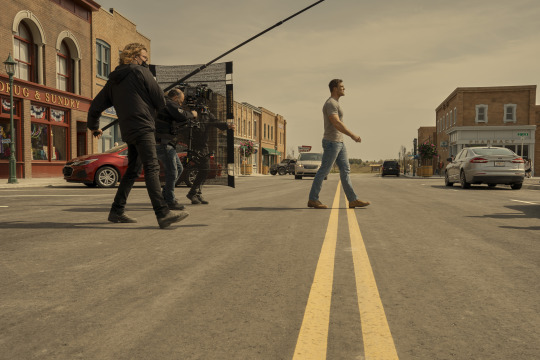
Reacher follows Jack Reacher, a veteran military police investigator who has just recently entered civilian life. Reacher is a drifter, carrying no phone and the barest of essentials as he travels the country and explores the nation he once served. When Reacher arrives in the small town of Margrave, Georgia, he finds a community grappling with its first homicide in 20 years. The cops immediately arrest him and eyewitnesses claim to place Reacher at the scene of the crime. While he works to prove his innocence, a deep-seated conspiracy begins to emerge, one that will require Reacher’s keen mind and hard-hitting fists to deal with. One thing above all is for sure: They picked the wrong guy to take the fall.
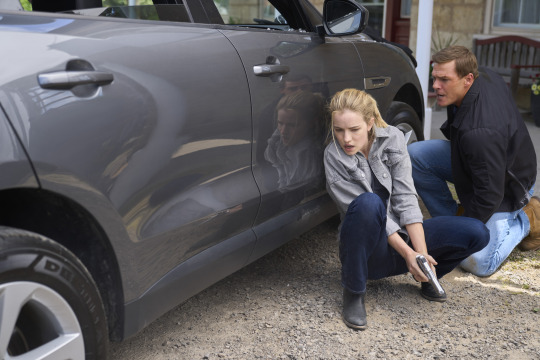
Season One of Reacher is based on Lee Child’s first Jack Reacher novel Killing Floor, and is written for television by Emmy-nominated writer Nick Santora (Scorpion, Prison Break), who also executive produces and serves as showrunner for the series as part of his overall deal with Skydance Television.
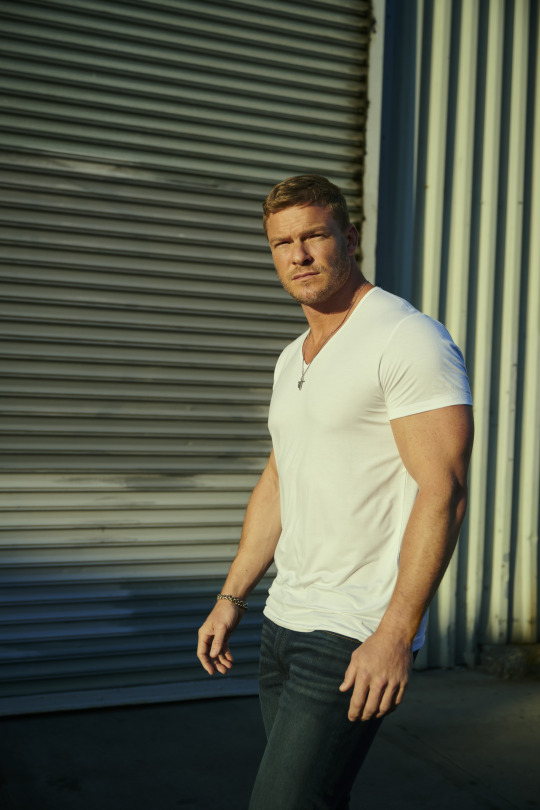
Further cast includes Malcolm Goodwin (iZombie) as Oscar Finlay, Willa Fitzgerald (The Goldfinch) as Roscoe Conklin, Chris Webster (Most Dangerous Game) as KJ, Hugh Thompson (Blessed Stranger: After Flight 111) as Baker, Maria Sten (Swamp Thing) as Frances Neagley, Harvey Guillén (What We Do in the Shadows) as Jasper, Kristin Kreuk (Smallville) as Charlie, Currie Graham (Murder in the First) as Kliner Sr., Marc Bendavid (Dark Matter) as Hubble, Willie C. Carpenter (Devious Maids) as Mosley, Maxwell Jenkins (Lost in Space) as Young Reacher, and Bruce McGill (My Cousin Vinny) as Mayor Teale. In addition to Santora, the series is executive produced by Lee Child, Don Granger, and Scott Sullivan, with David Ellison, Dana Goldberg, and Bill Bost for Skydance.
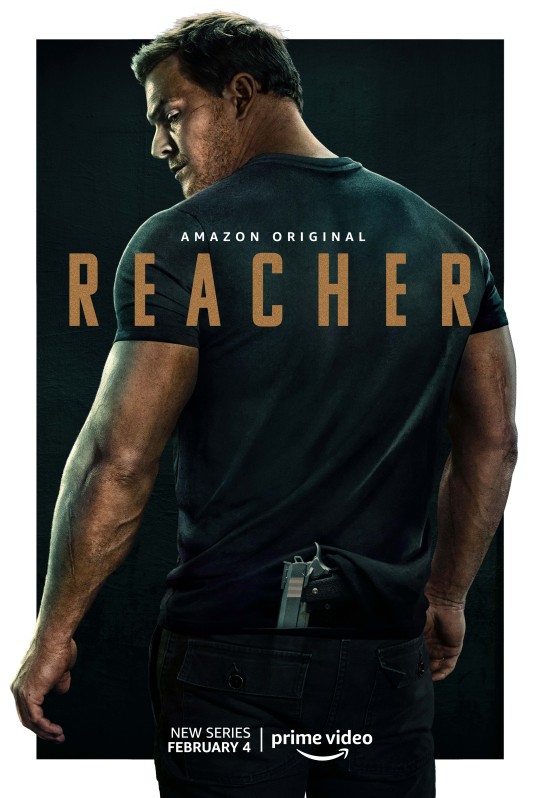
#series news#prime video#reacher#reacherseries#lee child#killing floor#nick santora#amazonprimevideo#alan ritchson#thriller#conspiracy#military#veteran
15 notes
·
View notes
Video
tumblr
“YOU WILL BE FOUND” NATIONAL COLLEGE ESSAY WRITING CHALLENGE 2021 | DEAR EVAN HANSEN
DEAR EVAN HANSEN “You Will Be Found” National College Essay Writing Challenge 2021
In partnership with Gotham Writers Workshop and the Broadway Education Alliance, DEAR EVAN HANSEN invited 11th-grade and 12th-grade students across the country to write a college-application style essay that describes how they channeled “You Will Be Found” to ensure those around them were a little less alone over the last year, or, alternatively, a moment where they found comfort in connection.
WINNER: Nearly 4,000 high school students across America wrote about impactful ways they stayed connected with others over the last year and we're delighted to announce Maxwell Silverman of Chicago, IL as the winner of the 2021 "You Will Be Found" National College Essay Writing Challenge and the $10,000 scholarship.
In June 2021, Maxwell graduated from Lane Tech High School in Chicago with plans to attend Boston Conservatory at Berklee, focusing on a degree in Musical Theatre.
FINALISTS: Seth Gorelik, Bellmore, NY Mira Kwon, Los Angeles, CA Anna Cappella, Pittsburgh, PA Semira Abdus-Salam, Rosedale, NY Filgey Borgard, Brooklyn, NY Lauren Escarcha, Orlando, FL Kacey Feth, Union, MO Paige Foltz, Stephens City, VA Sarah George, Chesterfield, MO Vincent Gerardi, Hauppauge, NY Ariane Lee, Syosset, NY Allison Lierz, Omaha, NE Megan Luong, New York, NY Kimberly Manyanga, Billerica, MA Orla Grace McCoy, Raleigh, NC Lucy Meola, New York, NY Sunaya DasGupta Mueller, Palisades, NY Liv Ollestad, Issaquah, WA Liana O'Rourke, Downers Grove, IL Isaiah Register, New York, NY Sydney Schneider, Los Angeles CA Ysanne Sterling, Centreville, VA Madeline Wiest, Peoria, AZ Samantha Williams, Providence, RI Laura Yee, New York, NY
FINAL ROUND JUDGES: Kelly Caldwell, Dean of Faculty, Gotham Writers' Workshop Logan Culwell-Block, Director of PLAYBILLder Operations and Community Engagement, Playbill Will Roland, Actor, Dear Evan Hansen Original Broadway Cast Member Crystal Su, Program Manager, The Jed Foundation Ekele Ukegbu, 2019 Jimmy Award Winner
READ MAXWELL’S FULL ESSAY:
Gram·pun·cle [geram-puhn-cuul] n. A gay man who formerly dated your grandmother only to later come to terms with his sexuality but still stay in the family to take care of your mother and aunt growing up.
Alan Palmer was my Grampuncle. When my cousins and I were younger, we couldn’t figure out what to call him. He was our grandpa in terms of age and raising our mothers, but he functioned more as the classic “fun gay uncle”, so we settled on a combination, Grampuncle. While we all had amazing relationships with Alan, mine was special. I have known Alan and his husband, Bill, since birth (making them the first ever gay couple I knew in my life).
Growing up and struggling with my sexuality, I was always able to look up to them to show me that true love really does have no boundaries. I will never forget, in 2015, standing inside the Michigan courthouse beside Alan as he and Bill exchanged vows and got married. They showed me, a young, insecure gay boy, that there was a place for me in the world and that I had a future to look forward to filled with love and joy.
Along with that joy, there eventually came some pain. Alan was diagnosed with stage 4 lung cancer in the early spring of 2020. A week or so after the diagnosis, the world fell into a global pandemic. Those first few months were intense. I heard the horror stories from Alan of how scary it was going into the hospital for rounds of chemotherapy with people who had the Coronavirus sitting in the next wing over. Being constantly in and out of the hospital he was a risk to others, and the lung cancer made almost everyone else a risk to him. With the exception of his husband, he was fully alone.
Alan did not admit to his loneliness and pain. He did not want to feel like a burden, but after talking with Bill and hearing how Alan was truly feeling, my family began to make the hour and a half drive from Chicago to Michigan almost every other week to visit. We brought Alan a pop-up gazebo and some fancy sun hats to protect him (with the radiation he could not be in the sun for more than a few minutes at a time), and we would sit in the backyard just talking and laughing for hours until Alan’s body would give in to the exhaustion and he had to go inside.
As his birthday approached, I racked my brain thinking of something special to do for him. I thought back to a video I saw online toward the beginning of the pandemic and decided to make a “hug shield”. What better gift to give than a loved one’s embrace during the pandemic? Using a clear painter’s tarp, I cut arm holes and taped together closed arm sleeves. It took a good few hours, but I finally figured out a design that allowed for full protection on either side of the hug. On the day of his birthday, we packed up the car and headed to Michigan.
After talking and eating cake, it was time for the surprise. As we pulled the shield out and hung it from the gazebo, Alan did something I had only seen at the courthouse; he cried. I had the honor of the first hug, and as I slipped my arms into the sleeves Alan and I held each other and cried together. He pressed his forehead against mine through the plastic and in between sobs he said to me, “I am so proud of you.” I knew this was our final goodbye. When Alan died the next week, I knew he went in peace. He had felt my embrace through the shield of love.
SEMI-FINALISTS: Bailey Andera, Thousand Oaks, CA Arianna Arroyo, Brooklyn, NY Alexis (Lexi) Berganio, Honolulu, HI Avery Bielski, Los Angeles, CA Henry Boemer, Villa Rica, GA Isabelle Bulmahn, Imperial, MO Jane Butera, Phoenixville, PA Mia Cashin, Norwell, MA Sean Choo, Rancho Palos Verdes, CA Zuri Clarno, Columbus, OH Lydia Corcoran, Apalachin, NY Cody Coyle, Winter Park, FL Anna Dai-Liu, San Diego, CA Alexander Guerrero Diaz, Richmond, VA Isabella Dufault, Irvine, CA Edwin Ellis, Atlanta, GA Laurel Emanuel, Raleigh, NC Aubrey Fisher, Cobden, IL Sunny Fong, Brooklyn, NY Sarah Galatoire, Houston, TX Zhao Gu Gammage, Wyncote, PA Sarah Gomez, Anaheim, CA Rachel Gray, Cleveland, OH Jameson Huge, Chicago, IL Sarah Grace Hutchinson, Alpharetta, GA Catheryn Ibegbu, Dearborn, MI Nicole Jo, Andover, MA Kelsey Johnston, Prince George, VA Gabrielle Kashorek, Avon, NY Samantha Kern, Akron, NY Nicole Kowalewski, Sykesville, MD Anne Lee, Edison, NJ Amelia Lin, Mukilteo, WA Judianne Meredith, River Vale, NJ Rabi Michael-Crushshon, Minneapolis, MN Geneva Millikan, Maumelle, AR Samantha Moy, Long Island, NY Shaakirah Nazim-Harris, Amityville, NY Eleanor Neal, Springfield, VA Sofia Ochoa, Camarillo, CA Basilia Oferbia, Brooklyn, NY Annika Olson, Rathdrum, ID Kaden Polt, Osmond, NE Shreeyamsa Poudel, Federal Way, WA Noah Robie, South Berwick, ME Zainely A. Sandoval Martinez, Dorado, PR Devyn Schoen, Eldred, PA Yusra Shaikh, Edison, NJ Gabrielle Shockley, Egg Harbor Township, NJ Ava Sklar, Brooklyn, NY Mia Sunday, Sammamish, WA Christina Unkenholz, Smithtown, NY Emilia Valencia, Portland, OR Brianna Wallace, Fredericksburg, VA Charles Wang, West Hartford, CT Daniel Joseph Weispfenning, Ridgewood, NJ Jennifer Wheeler, Reading, MA Virginia Zanella, Collierville, TN Alessandra Zepeda Ortiz, Los Angeles, CA Anna Zhang, New York, NY Daniel Zhang, Cortland, NY
10 notes
·
View notes
Text
‘MY GOOD WIFE’ v ‘MY FAVORITE HUSBAND’
June 23, 1949
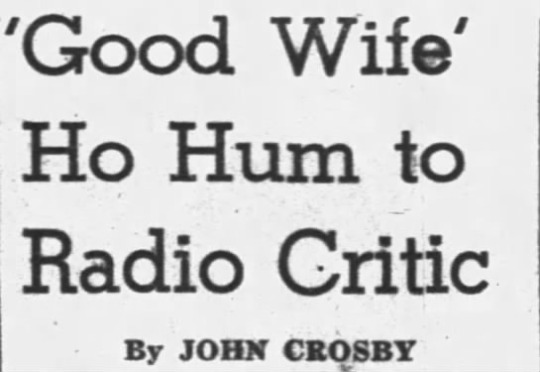
"My Good Wife," an added starter on KNBC, 6:30 p.m. PST Fridays, is another comedy about a young married couple, as if we needed another one. I must admit this one is a little different. This married couple, Steve and Kay Emerson, are not nearly so fast with a wisecrack as, say, Lucille Ball and her husband on "My Favorite Husband," 9:00 p.m. PST the same night on KCBS. Great night for matrimony, Fridays, and if those two programs don't provide enough for you, tune in Dorothy Dix at 1:45 pm. (not broadcast in west). She'll tell you how to win back an erring husband.
I haven't yet made up my mind whether the Emerson's ineptness at repartee is deliberate - after all, not every young wife talks like Groucho Marx - or whether the script writer isn't very good at it either. Anyhow, whether by accident or design, the Emersons are a very restful young couple, possibly a little too restful to get anywhere in the entertainment world. In radio, they're a real novelty.
As a wife Arlene Francis who plays Kay Emerson, wins out on points over Lucille Ball In other regards - talent and looks, for example - Miss Ball is way out front. But how long could you live with a girl who says: "Oh, we don't miss television. I climb in the Bendix and sing and George looks at me through the little window." Imagine having a girl around the house who said things like that before breakfast. It'd curdle the milk.
STARTS OFF FAST
“My Good Wife" started out at a gallop two weeks ago, NBC deciding to set the stage and get everything out of the way all at once. The first program resembled one at those synopses of previous in installments in the popular magazines. Steve met Kay, quarreled with her, married her, taught her how to drive, learned he was about to become a father, and became one - all in 15 minutes. One minute later, the dialogue went like this:
"It doesn't seem like we've been married 12 years."
"We've been married 10 years."
"Well, that's why it doesn't seem like 12."
That, incidentally, Is a little brighter than the conversation around the Emerson household generally gets.
On the second show of the series, the pace settled down to a walk. During the first few minutes the Emersons and their neighbors lay lazily on the grass, not even talking very much. This may be taking realism too far. I mean there ought to be some crickets chirping or something. Things quickened a bit later when Mrs. Emerson decided she was going to help her husband out with his law practice and, of course, messed things up.
YALE, NO LESS
The Emersons are quite upper middlebrow as radio's young married folk go. He went to Yale, for heaven's sake, and she not only went to Vassar but led the daisy chain or whatever they do with that daisy chain. What is this - counter revolution? Oh, yes, they live in Larchmont up to their ears in other upper middlebrows. I don't know what else to tell you about the Emersons except they sound like a nice young couple to have over for a drink some time but conceivably a little mild to entertain you much on the air.
My favorite young married couple is still Ozzie and Harriet Nelson - I put Goodman and Jane Ace off in another category entirely - and while we're chatting about this sort of thing, I ought to point out Ricky and David Nelson, Ozzie and Harriet's children, are now playing themselves on that program which solves a lot of problems. I have a spy in the Nelson household, named - in case any congressional ears are pricking - Harriet Nelson, nee Harriet Hilliard, and she is not now and has never been a Communist nor worked on the atom bomb nor designed the B-36.
Anyhow, my spy informed the Nelsons had a little trouble with the kids. The real Ricky and David I listened to the radio Ricky and David and discovered them doing things they weren't allowed to do or wouldn't do voluntarily if they were allowed. Being children, they got confused over their own identities. Well now the real Ricky and David are the radio Ricky and David and the split personalities in the kids has been averted. You run into a lot of funny problems in radio.
# # #
FOOTNOTES FROM THE FUTURE
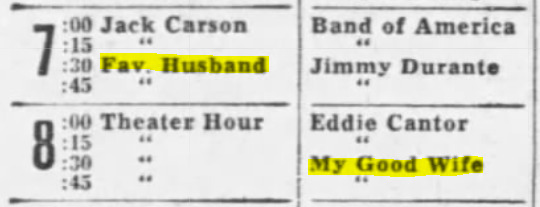
It seems pretty clear that NBC was counter-programming CBS’s “My Favorite Husband”. Not only are the names very similar, they were scheduled on the same night, as critic Crosby points out.
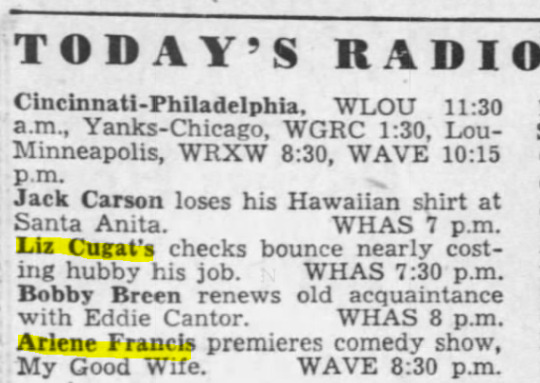
The episode of “My Favorite Husband” described above might apply to any domestic sitcom, but was actually titled “Budget - Mr. Atterbury” broadcast June 3, 1949. However, this newspaper is still calling Lucille Ball’s character Liz Cugat, when her name had changed to Liz Cooper in January 1949, to avoid comparison with the well-known bandleader (no, not Desi Arnaz).
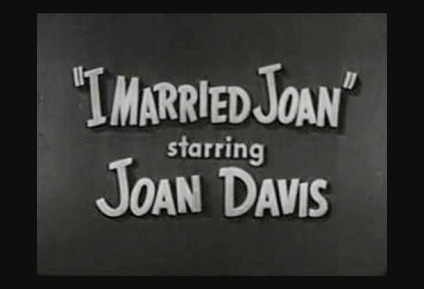
Counter-programming by NBC would not stop on radio. When “I Love Lucy” was a juggernaut hit for CBS TV, NBC created a similar show titled “I Married Joan” for star Joan Davis. It was billed as “The adventures of the scatterbrained wife of a respected city judge.” Substitute “bandleader” for “Judge” (played by Jim Backus) - and you’ve got “I Love Lucy.” Like Ball, Davis was a film star of the ‘30s and ‘40s getting aboard the TV bandwagon. Like Lucy, Joan wanted to be in showbusiness. Many of the same situations that Lucy got into, Joan did too. The series even featured a few “I Love Lucy” refugees: Jerry Hausner, Elvia Allman, Bob Jellison, Margie Liszt, Shirley Mitchell, Ross Elliott, and many others. "Lucy” and “Joan” even employed the same director in each show's first season, Marc Daniels. "Joan” lasted three seasons, from 1952 to 1955 and is all but forgotten today.
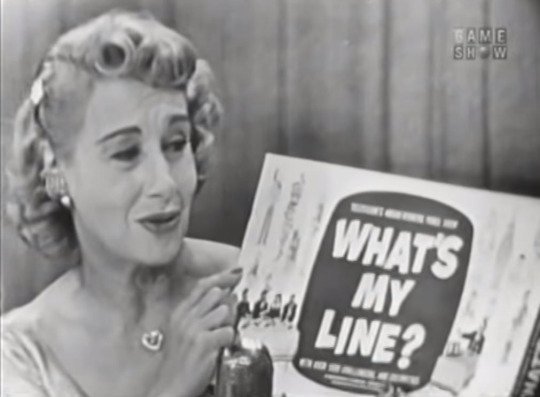
Kay Emerson was not the first domestic radio role for Arlene Francis. In 1940, she took over the role of Betty on “Betty and Bob”, which had been the first successful soap opera. She was one of the hosts of the quiz show “What’s My Name?” beginning in 1938. The show was seen as a model for TV’s “What’s My Line?” which premiered in 1950. Francis would stay with the show for its entire run, including six mystery guest appearances by Lucille Ball.
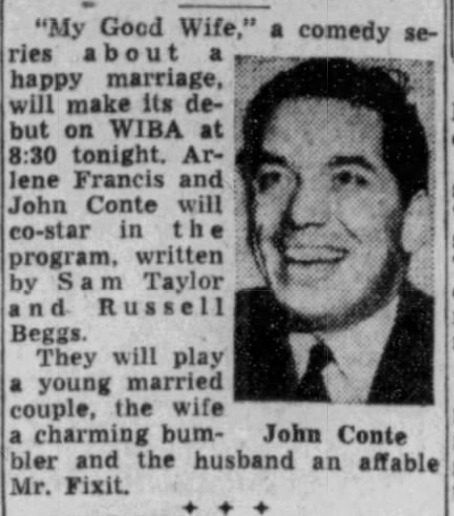
The husband to “My Good Wife” was played by John Conte. From 1944 to 1946 he was married to Marilyn Maxwell (1944-46) who would later appear with Lucille Ball in the 1963 film Critic’s Choice. He had also been seen with Ball (and Maxwell) in As Thousands Cheer (1943). In 1960 he would work for Desilu in an episode of “The Untouchables” (1960).
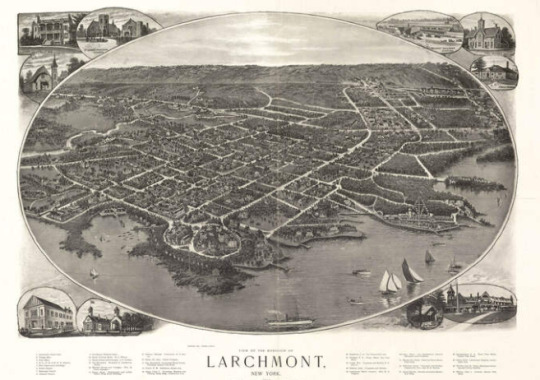
Unlike “My Favorite Husband’s” mythical mid-Western Sheridan Falls, the Emerson’s livid in the real New York suburb of Larchmont, an affluent village located within the Town of Mamaroneck in Westchester County, New York, approximately 18 miles northeast of Midtown Manhattan. Nearby was the town of New Rochelle, whose most famous fictional resident was Rob Petrie on “The Dick Van Dyke Show” (filmed at Desilu Studios). Danfield, New York, another fictional town in the area, was the residence of Lucy Carmichael and Vivian Bagley for the first three seasons of “The Lucy Show.”
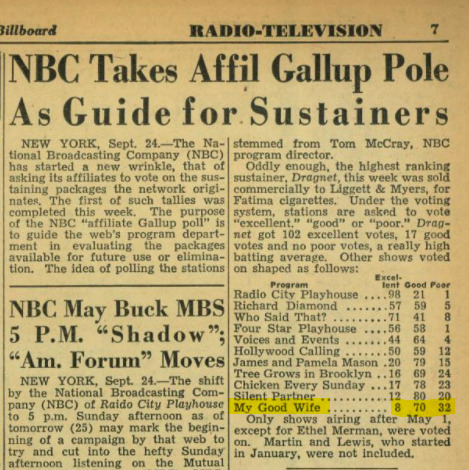
“My Good Wife” began airing in June 1949, and by April 1950 was nowhere to be found. In October 1949, Billboard reported on a new NBC Gallup Poll that placed the show dead last - with 32 stations voting it poor and only 8 saying it was excellent. The future of “Wife” was bleak. The sitcom was cancelled after 18 weeks to make room for the new Jimmy Durante show. Meanwhile, Ball’s “Husband” (on CBS), thrived. Coincidentally, the show was initially a replacement for Red Skelton’s show. Skelton and Durante had both worked with Ball on films.
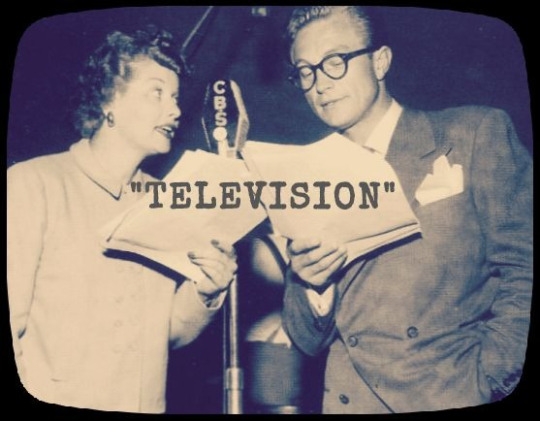
Crosby’s quote from “My Favorite Husband”
"Oh, we don't miss television. I climb in the Bendix and sing and George looks at me through the little window."
was spoken by Lucille Ball in the episode titled “Television” on June 17, 1949. A Bendix is a brand of front-loading washing machine. The porthole-like window was similar to the size screen of early television sets.

Crosby’s observation that Liz talks like Groucho Marx is attributable to the show’s writers Bob Carroll, Jr., Madelyn Pugh, and Jess Oppenheimer. And let’s not forget that Lucille Ball acted opposite Groucho Marx in Room Service (1938)!
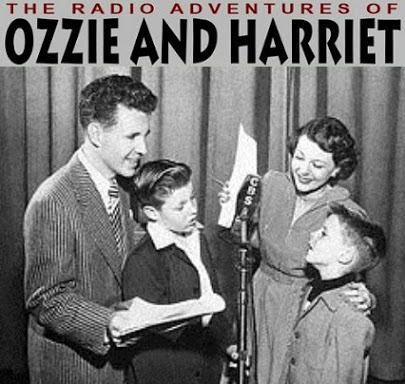
After making the obvious comparison to “My Favorite Husband,” Crosby lets readers know that neither “Husband” nor “Wife” will ever displace “The Adventures of Ozzie and Harriett” in his domestic dome. The show launched October 8, 1944 and a total 402 radio episodes were produced. When it was optioned for television, it was upstart network ABC that made the sweetest deal to the Nelsons.
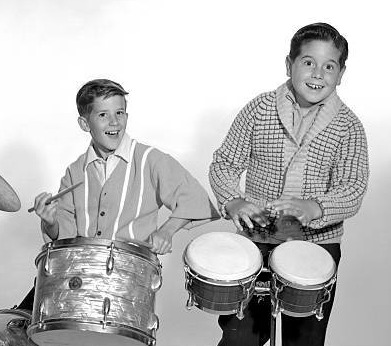
As Crosby alludes to, their real-life sons, David and Ricky, did not join the cast until the radio show's fifth year. The two boys were played by professional actors prior to their joining because both were too young to perform. Crosby’s allegations of possible identity crisis due to watching their parents with other sons on television, might easily apply to “I Love Lucy”, where the real-life Desi Arnaz often lived in the shadow of the young actors playing Little Ricky on television. Mrs. Ricardo and Mrs. Arnaz giving birth to both boys on the same day only added to the confusion - one that still lingers today.
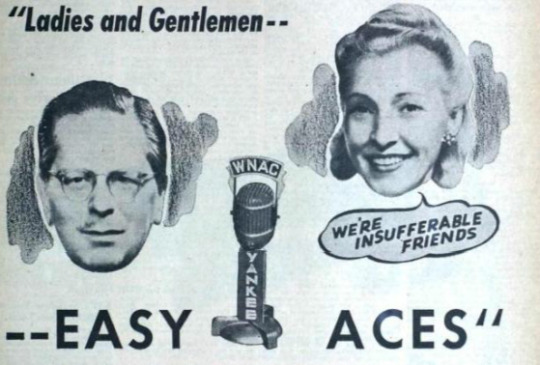
Crosby declines to compare the aforementioned shows with the popular Goodman and Jane Ace. The real-life marrieds had a show titled “Easy Aces” Goodman Ace cast himself as a harried real estate salesman and the exasperated but loving husband of the scatterbrained, malaprop-prone Jane ("Time wounds all heels"). “Easy Aces” became a long-running serial comedy (1930–1945) but did not make a graceful transition to television, lasting only a few months on the ill-fated DuMont Network. Coincidentally, Martin Gabel, who married Arlene Francis in 1946, had a recurring role on “Easy Aces” during the 1930s.
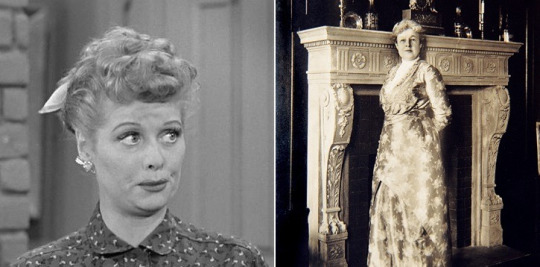
In a more sarcastic shout-out, Crosby mentions capping off this slew of domestic dithering by listening to Dorothy Dix. Author Elizabeth Meriwether Gilmer (1861-1951) was widely known by the pen name Dorothy Dix. As the forerunner of today’s popular advice columnists, Dix was America’s highest paid and most widely read female journalist at the time of her death. Her advice on marriage was syndicated in newspapers around the world with an estimated audience of 60 million readers. Naturally, radio was not neglected, getting their Dix fix when her column took to the airwaves. Due to Lucy’s insistence on interfering in the Mertz’s personal affairs, Ricky compares Lucy to Dorothy Dix in “Fred and Ethel Fight” (ILL S1;E22) on March 10, 1952.
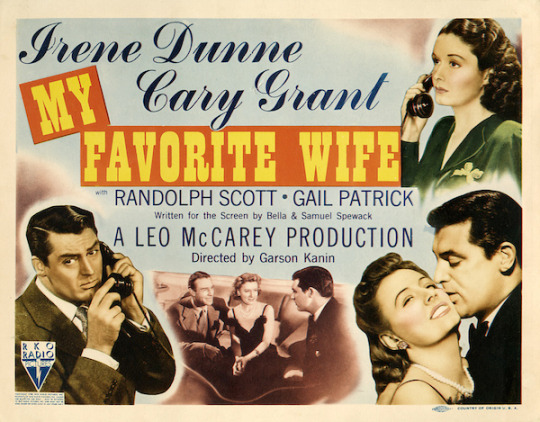
We haven’t yet mentioned this 1940 gem, but we’ll save that for another time!
#My Good Wife#Arlene Francis#John Conte#My Favorite Husband#Lucille Ball#radio#1949#I Married Joan#John Crosby#Dorothy Dix#Ozzie and Harriett#Easy Aces#Groucho Marx#Desi Arnaz Jr.#Larchmont NY
2 notes
·
View notes
Photo
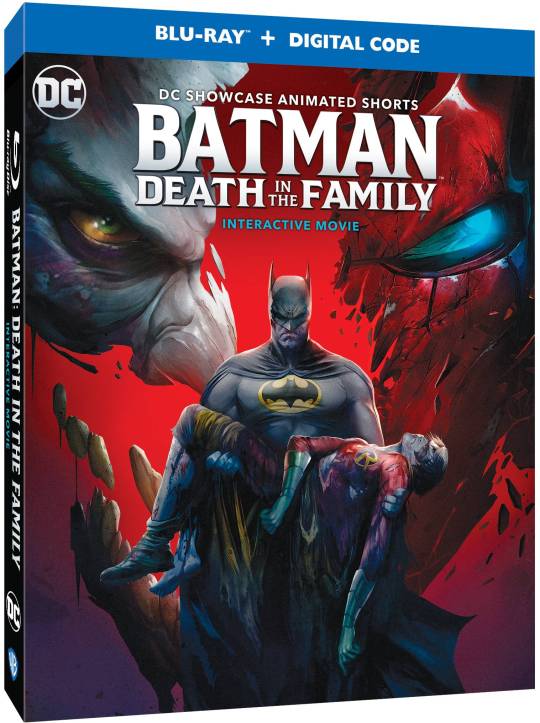


Warner Bros. Home Entertainment Brings BATMAN: DEATH IN THE FAMILY, THE FLINTSTONES: THE COMPLETE SERIES AND HAPPY HALLOWEEN, SCOOBY-DOO! to the New York Comic Con 2020.
Warner Bros. Home Entertainment (WBHE) presents three engaging panels – spotlighting the landmark interactive animated short Batman: Death in the Family, The Flintstones: The Complete Series remastered for Blu-ray™, and the all-new Happy Halloween, Scooby-Doo! – to New York Comic Con for the annual event’s new virtual streaming edition October 8-11, 2020. The Happy Halloween, Scooby-Doo! presentation will be the first-ever Con appearance featuring all four core voices of Mystery Inc. together on the same panel: Frank Welker (Fred & Scooby-Doo), Grey Griffin (Daphne), Matthew Lillard (Shaggy) and Kate Micucci (Velma). WBHE panels will spotlight never-before-seen footage, discussions with filmmakers, and showrunners, artists and actors. All three panels will be live-streamed through NYCC’s partnership with YouTube, and specific panel links will be found via the NYCC website at www.newyorkcomiccon.com.
Here’s a breakdown of the panels – and confirmed talent – appearing at New York Comic Con:
Saturday, October 10 1:15pm PT/4:15pm ET – BATMAN: DEATH IN THE FAMILY – AN INTERACTIVE TALE Warner Bros. Home Entertainment’s unveils its first-ever interactive film presentation with Batman: Death in the Family in a fascinating New York Comic Con panel. As the anchor of an anthology of 2019-2020 animated shorts, Batman: Death in the Family is based on the 1988 landmark DC event where fans voted by telephone to determine the story’s ending, and is organically grown out of the 2010 DC Universe Movie, Batman: Under the Red Hood. In this new version, the animated short is an interactive storytelling presentation with numerous “branches,” allowing the viewer multiple options from which to choose and alter the path of the core characters (Batman, Robin, Joker, Red Hood and more). Join producer/director/writer Brandon Vietti (Batman: Under the Red Hood, Young Justice), actors Bruce Greenwood (The Resident, Star Trek, iRobot), Vincent Martella (Phineas and Ferb, Everybody Hates Chris) and Zehra Fazal (Young Justice), and moderator Tiffany Smith (DC Daily) for an in-depth panel discussion about this innovative film. Produced by Warner Bros. Animation and DC, DC Showcase – Batman: Death in the Family arrives from Warner Bros. Home Entertainment on Blu-ray TM Combo Pack and Digital starting October 13.
Sunday, October 11 8:40am PT/11:40am ET – HAPPY HALLOWEEN, SCOOBY-DOO! Be part of the first-ever convention panel to feature the four core voices of the Scooby-Doo franchise as they chat about their all-new film, Happy Halloween, Scooby-Doo! – and then show you the first eight minutes of the movie! Scooby-Doo and Shaggy’s favorite holiday is upon us! With fake monsters and candy galore, Halloween is heaven for these hungry foodies going door-to-door. But this year, their sweet holiday turns sour when the neighborhood pumpkin patch is infected by toxic ooze, creating high-flying jack-o-lanterns, and a king-sized pumpkin leader squashing everything in its path. It’s up to Scooby-Doo and the gang as they team up with their pals, Elvira, Mistress of the Dark and Bill Nye the Science Guy, to solve this mystery of gigantic proportions and save Crystal Cove! Enjoy a fun panel discussion amongst voiceover legend Frank Welker (The Transformers), in his 50th year voicing Fred Jones and 18 th year voicing Scooby-Doo; Grey Griffin (DC Super Hero Girls films) in her 20 th year as Daphne Blake; Matthew Lillard (Twin Peaks, Bosch, Good Girls) celebrating his 18 th year as Shaggy Rogers; Kate Micucci (Unikitty!) in her fifth year as Velma Dinkley; Cassandra Peterson (Elvira, Mistress of the Dark), director/producer/writer Maxwell Atoms (Fish Hooks, The Grim Adventures of Billy & Mandy) and moderator Damian Holbrook (TV Guide Magazine senior writer). Then stay for a special sneak peek at the first eight minutes of the film. Happy Halloween, Scooby-Doo! arrives on DVD and Digital HD starting October 6.
Sunday, October 11 9:30am PT/12:30pm ET – THE FLINTSTONES TAKE NEW YORK! Celebrate the 60 th anniversary of the first animated family of primetime television – The Flintstones – with an entertaining panel at New York Comic Con. Join panelists director/producer Tony Cervone (SCOOB!, The Flintstones and WWE: Stone Age Smackdown!); actors Jeff Bergman (Our Cartoon President, Looney Tunes Cartoons), Grey Griffin (DC Super Hero Girls, Scooby-Doo franchise) and Eric Bauza (Looney Tunes Cartoons, UniKitty!), the voices of Fred Flintstone, Betty Rubble and Bam-Bam & Dino, respectively; animation historian & author Jerry Beck and moderator Yvette Nicole Brown (Community, Avengers: Endgame) as they discuss the landmark series, which has been fully- remastered for Blu-ray release by Warner Bros. Home Entertainment. The collectible box set includes all 166 episodes and two Flintstones feature-length animated films. The Flintstones: The CompleteSeries will be available to own on Digital HD starting October 6, and on Blu-ray on October 27.
BatmanNotes.com
20 notes
·
View notes
Text
Best Romantic Movies on Netflix
https://ift.tt/3a6cb9I
Romance movies are not that different from horror movies. Both are incredibly hard to pull off, are heavily watched during a cold time of year, and hopefully end with every character covered in blood.
With that in mind we present to you a list of the best romantic movies on Netflix. Because romance deserves it, damn it. Virtually every song ever written is a love song but poor romance can’t get a fair shake at the movies. Whether it be a rom-com or just a straight-up soul-enlightening/crushing romance, our list of the best romantic movies on Netflix will get you back in touch with your cold, dead heart.
Set It Up
Set It Up is Netflix’s most accomplished original romantic comedy yet.
Zoey Deutch and Glen Powell star as overworked assistants Harper and Charlie. Harper is an assistant to Kirsten (Lucy Liu) the woman behind a sports media empire. Charlie works for finance maven Rick (Taye Diggs). Harper and Charlie realize that their respective workloads might lesson if their bosses were more focused on their love life and less focused on work. So they…set them up.
Set It Up is a fun, novel high-concept romance movie positively filled with chemistry on all sides.
Outside In
We embrace every kind of love on our list of the best romance movies. Sometimes that includes some questionable, and some would say “icky” kind of love. So…Outside In is a teacher-student romance. But don’t panic! It’s ok.
Jay Duplas stars as Chris, a man who was wrongly imprisoned at age 18 and who is relased at age 38. When Chris is released, he immediately meets up with his old high school teacher, Carol (Edie Falco), who was his penpal when he was in prison. He wastes little time before he declares his love for her.
Despite its subject matter, Outside In is a mature, well-handled exploration of love and what it means to love someone for themselves as opposed to what they do for us.
The Guernsey Literary and Potato Peel Pie Society
With a name as long as The Guernsey Literary and Potato Peel Pie Society, the movie better be good to justify how many times we poor cultural commenters must type it out. Thankfully Guernsey is quite good!
Based on a book by the same name, Guernsey is a historical love story set in 1946. Lily James stars as British writer Juliet Ashton. Juliet begins exchanging letters with residents of the islands of Guernsey, which was under German occupation in WWII (so like two years before the movie starts). While there she meets the dashing Dawsey Adams (Michael Huisman) and romance begins to blossom.
The Guernsey Literary and Potato Peel Pie Society is an excellent, watchable classical romance
To All the Boys I’ve Loved Before
Oh hey! Another Netflix original with a long title based on a book. Like the Potato Peel Pie Society, To All the Boys I’ve Loved Before is another effortlessly enjoyable romantic romp – this time of the teen variety.
Lara Jean Song Covey (Laura Condor) experiences every young person’s nightmare when private love letters to five boys she has or has had crushes on suddenly and mysteriously become public. But fear not. This is a romance movie, not a horror movie. So this sudden reveal has to go well for Lara Jean, right? RIGHT?!?
To All the Boys P.S. I Still Love You
The To All the Boys team returns for a sequel that teaches kids the harsh lesson that there’s no such thing as happily ever after! OK, so that’s a bit harsh, but To All the Boys P.S. I Still Love You does bring back its characters for another round of romantic angst.
Read more
Movies
To All the Boys: P.S. I Still Love You Review
By Delia Harrington
Movies
To All the Boys I’ve Loved Before Review: A Pleasurable Netflix Rom-Com
By Delia Harrington
Lara Jean (Lana Condor) is now officially Peter’s (Noah Centineo) girlfriend. But before they can relax and enjoy their lives together, an old flame of Lara Jean enters the frame. That’s right, John Ambrose (Jordan Fisher) is here and he wants to steal your girl, Noah Centineo.
The Danish Girl
2015’s The Danish Girl tells the story of a kind of love nearly unprecedented for its early 20th century time. Eddie Redmayne stars as artist Lili Elbe, who was born Einar Wegener and is believed to be one of the first individuals to receive sexual reassignment surgery. The film follows Lili’s journey and her love with wife Gerda Wegener (Alicia Vikander).
When Gerda asks her husband to stand in for a female subject in her painting, Einar does so and quickly comes to terms with the gender identity he’s been suppressing. The newly confirmed Lili and Gerda navigate this new dimension of their relationship and Lili continues her work as a subject for Gerda’s now very much in demand paintings.
cnx.cmd.push(function() { cnx({ playerId: "106e33c0-3911-473c-b599-b1426db57530", }).render("0270c398a82f44f49c23c16122516796"); });
Beauty and the Beast
2017’s live-action version of Beauty and the Beast isn’t the best depiction of the classic fairy tale ever but that’s ok. It doesn’t have to be. All Bill Condon’s Beauty and the Beast really needed to be was a fun little dip into nostalgia with sumptuous visuals and a believable romance. On that front, everything goes according to plan.
Read more
Movies
Emma Watson on Beauty and the Beast: ‘I’m Very Grateful That This Character Exists’
By Don Kaye
TV
Beauty and the Beast Disney+ Prequel Series Set with Luke Evans and Josh Gad
By Joseph Baxter
Emma Watson stars as Belle and Dan Stevens is her beast. Belle heads off from her small French town to the Beast’s castle to rescue her father. What follows is Stockholm Syndrome: The Movie. But sexier. Beauty and the Beast really does look good and Watson and Stevens have just enough chemistry to make this a worthwhile romantic experience.
50 First Dates
50 First Dates has a somewhat disappointing Rotten Tomatoes score. Ignore that. It’s probably partially due to many critics’ distaste for at least one of the actors in the above screengrab. Not that they can be blamed. The presence of Adam Sandler or Rob Schneider in any comedy is rarely a good sign. In 50 First Dates‘, however, it’s not an issue at all.
50 First Dates is a legitimately funny and romantic romantic comedy. Drew Barrymore stars as Lucy Whitmore, a woman with short-term memory loss. Due to a car accident, every day she wakes up believing it is October 13, 2002. Sandler’s character Henry Roth meets her in Hawaii and the two must overcome this bizarre condition to establish a lasting relationship.
Carol
Todd Haynes, director of Carol and Far From Heaven knows longing. And if there’s an element that makes for an excellent romantic movie experience its longing. That desperate sense is baked into nearly every frame of Carol. Based on a 1950s romance novel, Carol is the story of a young photographer (Rooney Mara) and an older woman going through a divorce (Cate Blanchette) undertaking a forbidden affair.
Forbidden because, you know, ’50s. And that’s where the longing comes in. Nothing is more romantic or sexier than a forbidden romance. Carol channels that romantic energy into something mature, fascinating and heartbreaking.
Silver Linings Playbook
Silver Linings Playbook is all about how generally terrible it is to be a Philadelphia Eagles fan. OK, fine – it’s only a little bit about that. This star-studded 2012 film from David O. Russell is more about the challenges in finding love when one isn’t sure they even love themselves.
Bradley Cooper stars as Pat Solitano Jr., a young man with bipolar disorder living with his parents after being released from a psychiatric hospital. Pat is determined to win back his ex-wife and to that end enlists the help of young widower Tiffany Maxwell (Jennifer Lawrence). The two become closer as they train for an upcoming dance competition and share their respective damages with one another.
Silver Linings Playbook works because Lawrence and Cooper have a real crackling chemistry. And they both just happen to be devastatingly, almost supernaturally attractive.
Runaway Bride
From stars Richard Gere and Julia Roberts to director Garry Marshall to conspicuous usage of enormous cell phones – Runaway Bride is an intensely ’90s film. And to the rightly organized mind, that just makes it the platonic ideal of a low-stress romantic comedy.
Roberts stars as Maggie Carpenter, an alluring young woman who has made a habit of leaving multiple fiancé’s at the altar. Gere is Ike Graham, a New York columnist seeking to tell the definitive story of this “runaway bride.” Runaway Bride is a charming experience that will make you think long and hard about how you really like your eggs prepared.
Loving
It feels reductive to call Loving a “romance” movie, as its more of a historical exploration of the very real, very tragic legacy of American racism. At its center, however, the film is about love.
Loving tells the story of Richard (Joel Edgerton) and Mildred Loving (Ruth Negga), a mixed-race Virginia couple challenging their state’s law against interracial marriage in the Supreme Court. The details of the Lovings struggle for basic human rights are astonishing. Edgerton and Negga’s empathetic performances make sure the film never loses sight of the humanity at play amid all the legal drama.
Always Be My Maybe
Everyone always talks about “the one who got away”, but what about “the one who was always kind of around”? 2019’s Always Be My Maybe tells of one such story.
Ali Wong (who wrote the film) stars as Sasha Tran and Randall Park stars as Marcus Kim. Marcus and Sasha grew up next door to each other and also embarked on a brief, ill-fated relationship in their teenage years. When Sasha returns to San Francisco to open a restaurant, she discovers that romantic energy remains between her and Marcus. But is that enough to spark love in the busy, chaotic adult world?
Always Be My Maybe has a lot to say about family and growth. It also features a truly winning performance from Keanu Reeves playing…Keanu Reeves.
The Kissing Booth
There’s an interesting dynamic at play in teenage romantic comedies. Oftentimes, the worse they are, the more watchable (and rewatchable) they become. The Kissing Booth is a prime example. Based on a book by the same name from Beth Reekles, The Kissing Booth isn’t exactly celebrated for its realistic portrayal of American teenagers.
Thanks to charming lead performances from Joey King, Jacob Elordi, and Joel Courtney, however, that doesn’t really matter. The Kissing Booth is all about how one girl’s first kiss turns into an emotional minefield of teen angst. That alone is enough to support 105 minutes of pure high school drama…and two sequels!
The post Best Romantic Movies on Netflix appeared first on Den of Geek.
from Den of Geek https://ift.tt/38Fd7ho
6 notes
·
View notes
Text
hello ! below the cut are some of my muses that i’m dying to play so if any of them tickle ur fancy or are your wanted opposites just hit the lil heart n we can plot some stuff out <333
dahlia fernandez 19 - 24, model / social media influencer - cindy kimberly.
annabelle taylor 24 - 29, helps family run chain of gyms cross country - lily james.
ivy taylor 19-24, nursing major & kind of a bitch - amalia williamson.
ainsley taylor 25-30, nurse in a big hospital - brie larson.
veronica rossi 20 - 25, owns a diner / single mother - ariana grande.
harper ellis 19 - 24, fashion vlogger - natalia dyer / verse dependent cindy kimberly.
gia santos 20 - 25, works at a hooters / student undecided major who kinda wants to vlog - madison beer.
alexandra bridgers 20 - 25, socialite / works with special needs children at a horse ranch - madelaine petsch.
elena cruz 28 - 33, a server at her family’s restaurant - alexandra daddario.
charlotte florentina 19 - 24, vlogger / social media influencer - ludovica martino.
laila huang 19 - 24, aspiring singer / works at a pizza shop - lisa manoban.
maggie adams 19 - 24, related to tristan, just inherits his money and helps around the club - danielle campbell.
noelle chen 30 - 35, very well known fashion designer - gemma chan.
camila cortez 31 - 36, high school english teacher - melissa fumero.
cleo ‘cj’ jansen 19 - 24, student / messy, undecided major - josefine frida pettersen.
georgie abbott 19 - 24, volunteers at a library, journalism & psychology major - milena tscharntke.
roxanne brown 19 - 24, film major / takes videos of skateboarders for thrasher w zane - diamond white.
natasha wellington 19 - 24, living off her dad’s money, but she’s humble so she’s a manager at a pacsun - nicola peltz.
daphne hughes 19-24, probably high or drunk 24/7 & a professional dancer - haley lu richardson.
rosalie karlsson 19-24, v wealthy & a student / literature major - marilyn lima.
maxine richardson 19-24, helps manage her brothers band - abigail cowen.
yasmine gonzalez 25-30, owns a bar with her two brothers - emeraude toubia.
nicolette gonzales 20-25, bitchy actress who doesn’t want to end up working at her siblings bar - sofia carson.
ophelia williams 20-25, model & victoria’s secret angel - sophie turner.
paisley andrews 19-24, mass communications major & blogger - thalia crawford.
carmen espinoza 19-24 rich girl with daddy issues / receptionist at moms law firm - irene ferreiro garcia
joaquin juarez 19-24, soccer player for fc barcelona - diego tinoco.
nikolai gervais 20-25, world known chef - harry styles.
warren bryant 19-24, vlogger like scotty sire - nick robinson.
tristan thomas 33-38, owns a club & is the leader of an underground shady ass gang - charlie hunnam.
dante simmons 21-26, something major / student teacher, probably fucking his professor - keith powers.
zane bishnoi 22-27, film major / films skateboarders for thrasher w roxanne - avan jogia.
marco cruz 26-31, college dropout who now works at the apple store, alcoholic who cant stay sober - matthew daddario.
joseph auva’a 20-25, nfl player - kj apa.
vincent gonzales 22-27, owns a bar with his brother and sister - jordan connor.
valentino gonzales 28-33, owns a bar with his brother and sister / drug dealer - peter gadiot
kaleb donahue 25-30, bachelor prince next in line for the throne - daniel sharman.
adrian karlsson 23-28, v wealthy & shady businessman kinda like don draper - bill skarsgard.
jackson taylor 28-33, firefighter or police officer ( verse dependant ) - scott eastwood.
zachary taylor 19-24, student / music major - logan shroyer.
noah thompson 22-27, film major & just started working at warner bros - dylan o'brien.
liam moretti 45-50, carpenter / father of frankie and rex - mark ruffalo.
frankie moretti 26-31, line cook at the diner veronica owns - matthew daddario.
rex moretti 19-24, youtuber kinda like cody ko - noah centineo.
elijah baker 32-37, special education teacher - chris evans.
axel savea 35-39, traveling reporter for cnn - jason momoa.
theo leblanc 21-24, nhl player on the same team as caspian - timothee chalamet.
matthias leblanc 19-24, ghost writer for major artists - maxence danet fauvel.
elliot davis 20-25, works at the music store his uncle owns / wants to start a band - bradley simpson.
jordan ali 32-37, an actor aka hollywood’s golden boy - rami malek.
caspian brown 20-25, rich ass nhl player on the same team as theo - herman tommeraas.
maddox richardson 19-24, professional skater & in an underground band - luke hemmings.
augustus liu 19-24, in an underground band - calum hood.
milo young 25-28, drummer for a famous band - ben hardy.
diego velasquez 19-24, son of the prime minister of spain / is a big bratty asshole - benjamin wadsworth.
luca romano 20-25, owns the family car garage / mechanic - giancarlo commare.
giovanni lombardi 20-25, professional skateboarder - ludovico tersigni.
emmett o'hare 27-32, architect who’s addicted to gambling his money away - richard madden.
nathaniel o'hare 20-25, writer who has a hard time completing his work - michel biel.
gabriel miller 30-35, owns an alcohol distribution company with his brother - chris hemsworth.
maxwell miller 24-29, owns an alcohol distribution company with his brother - liam hemsworth.
finnegan jacobs 20-25, used to play professional footie and is now an aspiring disney animator - harry styles.
sawyer casey 19-24, college drop out / twitch.tv streamer & pro gamer - tom holland.
18 notes
·
View notes
Text
Celebrity Deaths 2018
JANUARY Jon Paul Steuer - Jan. 1 (TV Actor) Robert Mann - Jan. 1 (Violinist) Rick Hall - Jan. 2 (Music Producer) Thomas Monson - Jan. 2 (Religous Leader) Bruce Halle - Jan. 4 (Entrepreneur) John Young - Jan. 5 (Astronaut) Jerry Van Dyke - Jan. 5 (TV Show) *Dick Van Dyke's Brother* Donnelly Rhodes - Jan. 8 (TV Actor) Doreen Tracey - Jan. 10 (TV Actor) Eddie Clarke - Jan. 10 (Guitarist) Jessica Falkholt - Jan. 11 (TV Actress) Keith Jackson - Jan. 12 (Sportscaster) Bobby Zarin - Jan. 13 (Reality Star) Dolores O'Riordan - Jan. 15 (Rock Singer) Peter Wyngarde - Jan. 15 (TV Actor) Bradford Dillman - Jan. 16 (Movie Actor) Jo Jo White - Jan. 16 (Basketball Player) Jessica Falkholt - Jan. 17 (TV Actress) Dorothy Malone - Jan. 19 (Movie Actress) Fredo Santana - Jan. 19 (Rapper) Olivia Cole - Jan. 19 (TV Actress) Dorothy Malone - Jan. 19 (Movie Actress) Paul Bocuse - Jan. 20 (Chef) Jim Rodford - Jan. 20 (Musician) Bob Smith - Jan. 20 (Activist) Connie Sawyer - Jan. 21 (TV Actress) Ursula K. Leguin - Jan. 22 (Children's Author) Hugh Masekela - Jan. 23 (Composer) Joel Taylor - Jan. 23 (Meteorologist) Nicanor Parra - Jan. 23 (Poet) Lari White - Jan. 23 (Country Singer) Mark E. Smith - Jan. 24 (Punk Singer) Warren Miller - Jan. 24 (Director) Ingvar Kamprad - Jan. 27 (Entrepreneur) **Mark Salling - Jan. 30 (TV Actor) Louis Zorich - Jan. 30 (TV Actor) Ann Gillis - Jan. 31 (Movie Actress) Rasual Butler - Jan. 31 (Basketball Player) Leah LaBelle - Jan. 31 (Pop Singer)
FEBRUAY Dennis Edwards - Feb. 1 (Rock Singer) John Mahoney - Feb. 4 (TV Actor) Khalif Smith - Feb. 5 (Youtuber Star) Mickey Jones - Feb. 7 (TV Actor) Ebony Reigns - Feb. 8 (Reggae Singer) John Gavin - Feb. 9 (Movie Actor) Reg E. Cathey - Feb. 9 (TV Actor) Jóhann Jóhannsson - Feb. 9 (Composer) Vic Damone - Feb. 11 (Pop Singer) Jan Maxwell - Feb. 11 (TV Actress) Daryle Singletary - Feb. 12 (Country Singer) Marty Allen - Feb. 12 (Comedian) Morgan Tsvangirai - Feb. 14 (Politician) Billy Graham - Feb. 21 (Religious Leader) Emma Chambers - Feb. 21 (TV Actress) Nanette Fabray - Feb. 22 (TV Actress) Ensa Cosby - Feb. 23 (Family Member) *Bill Cosby's Daugher* Bud Luckey - Feb. 24 (Cartoonist) Sridevi Kapoor - Feb. 24 (Movie Actress) Rogelio Guerra - Feb. 28 (Soap Opera Actor)
MARCH David Ogden Stiers- March 3 (TV Actor) Roger Bannister - March 3 (Runner) Hubert de Givenchy - March 10 (Fashion Designer) Ken Dodd - March 11 (Comedian) Craig Mack - March 12 (Rapper) Nokie Edwards - March 12 (Guitarist) Stephen Hawking - March 14 (Physicist) Jim Bowen - March 14 (Game Show Host) Ed Charles - March 15 (Baseball Player) Tom Benson - March 15 (Entrepreneur) Tripp Halstead -March 15 (Blogger) Dushon Monique Brown - March 13 (TV Actress) Mike MacDonald - March 17 (Comedian) Charles Lazarus - March 22 (Entrepreneur) Fergus Anckorn - March 22 (War Hero) Morgana King - March 22 - (Movie Actress) Dushon Monique Brown - March 23 (TV Actress) Stéphane Audran - March 27 (Movie Actress) Rusty Staub - March 29 (Baseball Player) Bill Maynard - March 30 (Comedian)
APRIL Steven Bochco - April 1 (TV Producer) Winnie Madikizela-Mandela - April 2 (Politician) Susan Anspach - April 2 (Movie Actress) Ray Wilkins - April 4 (Soccer Coach) Eric Bristow - April 5 (Darts Player) Tim O'Connor - April 5 (TV Actor) Cecil Taylor - April 5 (Pianist) Jonathan Pitre - April 6 (Activist) Chuck McCann - April 8 (TV Actor) Art Bell - April 13 (Radio Host) R. Lee Ermey - April 15 (TV Actor) Pamela Gidley - April 16 (Movie Actress) Hal Greer - April 16 (Basketball Player) Harry Anderson - April 16 (TV Actor) Barbara Bush - April 17 (Political Wife) Dale Winton - April 18 (TV Show Host) Avicii - April 20 (DJ) **Verne Troyer - April 21 (Movie Actor) Bob Dorough - April 23 (Jazz Singer) Johnny Bennett - April 25 (TV Show Host) Kristin Nelson - April 27 (TV Actress) Judith Leiber - April 28 (Fashion Designer) Lil Lonnie - April 29 (Rapper) Robert Mandan - April 29 (Soap Opera Actor)
MAY Scott Hutchison - May 10 (Guitarist) Hubert de Givenchy - May 10 (Fashion Designer) Margot Kidder - May 13 (Movie Actress) Doug Ford - May 14 (Golfer) Tom Wolfe - May 14 (Journalist) Hugh Dane - May 16 (TV Actor) Joseph Campanella - May 16 (TV Actor) Young King Dave - May 17 (Instagram Star) Stephanie Adams - May 18 (Model) Robert Indiana - May 19 (Pop Artist) Clint Walker - May 21 (Movie Actor) Nara Almeida - Nay 21 (Fashion Designer) Allyn Ann McLerie - May 21 (Dancer) Philip Roth - May 22 (Novelist) Elizabeth Sung - May 22 (TV Actress) John Bain - May 24 (Youtube Star) Blake Painter - May 24 (Reality Star) Jerry Maren - May 24 (Movie Actor) Blake Painter - May 25 (Reality Star) Cornelia Frances - May 28 (TV Actress)
JUNE Sophia Gall - June 1 (Instagram Star) Georgann Johnson - June 4 (TV Actress) Dwight Clark - June 4 (Football Player) **Kate Spade - June 5 (Fashion Designer) Alan O'Neill - June 6 (TV Actor) Peter Stringfellow - June 7 (Entrepreneur) Anthony Bourdain - June 8 (Chef) Jackson Odell - June 8 (Movie Actor) Eunice Gayson - June 8 (Movie Actress) Neal Boyd - June 10 (Opera Singer) D.J. Fontana - June 13 (Drummer) Matt Murphy - June 15 (Guitarist) Leslie Grantham - June 15 (Soap Opera Actor) Xxxtentacion - June 18 (Rapper) Big Van Vader - June 18 (Wrestler) Sophie Gradon - June 20 (Reality Star) Charles Krauthammer - June 21 (Journalist) Vinnie Paul - June 22 (Drummer) The Random Toon Show - June 24 (Youtube Star) Richard Harrison - June 25 (Reality Star) Harlan Ellison - June 27 (Novelist) Steve Soto - June 27 (Musician) **Joe Jackson - June 27 (Talent Manager) *Michael Jackson's Father* Emily Hayward - June 28 (Youtube Star) Derrick O'Connor - June 29 (Theatre Actor) Steve Ditko - June 29 (Cartoonist) Smoke Dawg - June 30 (Rapper)
JULY Alan Longmuir - July 2 (Bassist) Richard Swift - July 3 (Music Producer) Ed Schultz - July 5 (Radio Host) Claude Lanzmann - July 5 (Director) Alan Longmuir - July 7 (Bassist) Tab Hunter - July 8 (Movie Actor) Jorge Valenzuela - July 8 (World Music Singer) Annabelle Neilson - July 12 (Reality Star) Roger Perry - July 12 (TV Actor) Ray Emery - July 15 (Hockey Player) Jon Schnepp - July 19 (Director) Elmarie Wendel - July 21 (TV Actress) Oliver Dragojevic - July 28 (Rock Singer) Arielis Paulino - July 29 (TikTok Star) Nikolai Volkoff - July 29 (Wrestler)
AUGUST Rick Genest - August 1 (Tattoo Artist) C. Struggs - August 3 (Rapper) *Charlotte Rae - August 5 (TV Actress) Barry Chuckle - August 5 (Comedian) Stan Mikita - August 7 (Hockey Player) Jill Janus - August 14 (Metal Singer) **Aretha Franklin - August 16 (Soul Singer) Atal Bihari Vajpayee - August 16 (Politician) Kofi Annan - August 18 (Politician) Craig Zadan - August 20 (Film Producer) **Stefan Karl Stefansson - August 21 (TV Actor) Barbara Harris - August 21 (Movie Actress) Ed King - August 22 (Rock Singer) Robin Leach - August 24 (TV Show Host) John McCain - August 25 (Politician) Neil Simon - August 26 (Playwright) Vanessa Marquez - August 30 (TV Actress)
SEPTEMBER Bill Daily - Sept. 4 (TV Actor) Burt Reynolds - Sept. 6 (Movie Actor) **Mac Miller - Sept. 7 (Rapper) Kim Porter - Sept. 11 (Movie Actress) Rachid Taha - Sept. 12 (Rock Singer) Marin Mazzie - Sept. 13 (Stage Actress) Denis Norden - Sept. 19 (Radio Host) Al Matthews - Sept. 22 (Movie Actor) Chas Hodges - Sept. 22 (Rock Singer) Gary Kurtz - Sept. 23 (Film Producer) PeeWeeToms - Sept. 28 (Youtube Star) Kim Larsen - Sept. 30 (Rock Singer)
OCTOBER Charles Aznavour - Oct. 1 (Pop Singer) Geoff Emerick - Oct. 2 (Sound Desinger) Will Vinton - Oct. 4 (Film Producer) Audrey Wells - Oct. 4 (Screen Writer) Hamiet Bluiett - Oct. 4 (Saxophonist) **Scott Wilson - Oct. 6 (Movie Actor) Peggy McCay - Oct. 7 (Soap Opera Actress) Paul Allen - Oct. 15 (Entrepreneur) Dennis Hof - Oct. 16 (Entrepreneur) Oli Herbert - Oct. 17 (Guitarist) James Karen - Oct. 23 (Movie Actor) Ntozake Shange - Oct. 27 (Poet) James Karen - Oct. 28 (Movie Actor) Jin Yong - Oct. 30 (Novelist) Willie McCovey - Oct. 31 (Baseball Player)
NOVEMBER Roy Hargrove - Nov. 2 (Trumpet Player) Sondra Locke - Nov. 3 (Movie Actress) **Stan Lee - Nov. 12 (Comic Book Author) David Pearson - Nov. 12 (Race Car Driver) Katherine MacGregor - Nov. 13 (TV Actress) Kim Porter - Nov. 15 (Model) Roy Clark - Nov. 15 (TV Show Host) Devin Lima - Nov. 21 (Pop Singer) Nicolas Roeg - Nov. 23 (Director) Ricky Jay - Nov. 24 (TV Actor) Stephen Hillenburg - Nov. 26 (Director) Bernardo Bertolucci - Nov. 26 (Director) *George H.W. Bush - Nov. 30 (US President)
DECEMBER Ken Berry - Dec. 1 (TV Actor) Geoff Murphy - Dec. 3 (Director) Philip Bosco - Dec. 3 (Stage Actor) Pete Shelley - Dec. 6 (Punk Singer) Nancy Wilson - Dec. 13 (Jazz Singer) **Penny Marshall - Dec. 17 (Director) Donald Moffat - Dec. 20 (Movie Actor)
6 notes
·
View notes
Photo

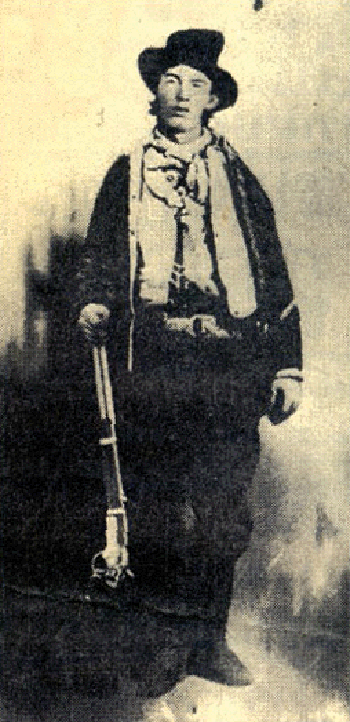
Henry “Billy The Kid” McCarty 1859-1881
His real name was Henry McCarty and he was born in New York City. His father died when he was a child. His mother Catherine moved West with him and his brother Joseph. She supported them by operating various hotels, boardinghouses, and laundries. They were living in Wichita, Kansas in 1871 when she sold all her properties. She had been diagnosed with tuberculosis, and had probably been advised to move to a drier climate. Billy was 12. They moved to Silver City, New Mexico. On March 1, 1873, she finally married William H. Antrim, who had courted her for several years. She operated a boardinghouse and William worked in the mines. She died a year later.
Watching his mother slowly die may have somehow affected Billy. He no longer attended school. He took up poker. Finally Antrim agreed to let the Truesdall family take him in. They operated the Star Hotel. He worked for his keep by waiting tables and doing kitchen chores.
In 1875, his first brush with the law occurred when he was arrested for stealing clothes from two Chinese. He escaped from jail and was on the run ever after. About this time he changed his name to William H. Bonney, probably to spare his family name.
On August 17, 1877, he killed his first man. This was near Camp Grant, Arizona at a saloon. The victim was a blacksmith named Windy. He had been constantly tormenting the young, slender teenager Billy, slapping him around and wrestling him to the floor. Finally Billy had enough and shot him. He fled town and wandered among the cow towns of New Mexico and Arizona, working at odd jobs.
Finally he arrived in Lincoln County, New Mexico. He arrived just about the time the Lincoln County War was about to heat up. It erupted because of the land monopoly by John Chisum, whose ranch was one of the largest in the west. Billy was working at the Coe ranch one of the smaller ranches infringing on Chisum’s space. The co-enemy was L.G. Murphy & Co. who the ranchers saw as unfairly inflating prices in their stores. John Tunstall, an Englishman who had set up a competing mercantile, took Billy in and outfitted him.
The war erupted in February 1878. Alexander McSween, a lawyer, had been retained by the late Lt. Col. Fritz’s brother and sister to collect a $10,000 life insurance policy. Fritz was the partner of Murphy. McSween was on Tunstall’s side. There was a delay of several months while McSween attempted to find out if there were any other heirs. Murphy & Co. persuaded the heirs to sue for failure to deliver. In February, a “sheriff’s posse,” rode out to the Tunstall ranch demanding payment of the debt with Tunstall’s property. Billy and others urged him to fight but Tunstall said nothing was worth losing your life over. While riding in to Lincoln with his herd, another Murphy group, not knowing that Tunstall had basically given in, caught up with them and shot Tunstall dead.
Tunstall was a good friend, almost a family member of the Kid, and his death was tragic for Billy. He swore revenge on all those who had been responsible. A group of vigilantes called The Regulators, including Billy, went out after the Dolan gang, part of Murphy’s bunch. But Dolan was ready and soon Billy found himself in jail. A few days later he was free and he and his friends again went out and captured Billy Morton and Frank Baker. Those two died while attempting to escape from jail. Soon after, Billy, now the leader of the group with Doc Scurlock were involved in a shootout with Sheriff Brady, who was in Dolan’s pocket. Brady was killed.
Billy continued to roam the county looking for others involved in Tunstall’s death. They were involved in another shootout, this time with Andrew “Buckshot” Roberts, who had been in the sheriff’s posse. Billy’s friend Bowdre actually shot Roberts, but Billy got blamed. Now there was a price on his head.
In May, the governor appointed George Peppin the new sheriff. Unfortunately he was also on the payroll of Murphy & Co. He and his posse harassed Billy and The Regulators all spring and early summer. His posse was largely made up of deputized outlaws and desperadoes. Billy’s friend Frank McNab was killed. His friend Ab Sanders was badly wounded and Frank Coe was taken into custody.
On July 11, 1878, Billy joined forces with a large band of Mexicans led by his old friend Martin Chavez. Peppin hired a new posse. He appealed to Col. N. A. M. Dudley at nearby Fort Stanton to give him some men.
Dudley complied, even though the U.S. military was not supposed to get involved with civilian disputes. He needed Murphy’s supplies of goods and services. It was a standoff. The two factions traded shots at the city of Lincoln.
On July 19, 1878, the enemy set fire to McSween’s house. As Billy and his friends attempted to rescue McSween, the posse shot McSween five times and killed him. Billy and his friends fled unharmed. They hid out at Fort Sumner on the Pecos River where Billy had many friends. They worked at nearby ranches for awhile. It was about this time that Billy met Pat Garrett, who then was a bartender for Beaver Smith’s saloon/gambling hall.
On February 18, 1879, Billy and Tom O’Folliard rode into Lincoln to meet with Dolan and Jesse Evans to discuss a truce. Supposedly the truce was made but immediately Campbell killed H. J. Chapman, Mrs. McSween’s lawyer and set fire to his body. The new governor Lew Wallace, a former civil war general and future author of Ben Hur, was furious. He called for the immediate arrest of Dolan Evans and Campbell. He also offered a $500 record to bring an Billy as a witness. The kid was afraid to come in though because of past charges against him. So Wallace arranged a secret meeting with Billy. The governor promised him a pardon if he would testify. When Billy said he was still worried the Dolan gang would try to get him, Wallace promised full protection.
An “arrest” was set up and Billy was taken in. On March 23, 1879, he gave a detailed statement regarding the rustling activities in the county. In April he testified before the grand jury. Unfortunately no one was convicted due to corruption, and soon Billy then found himself about to be tried for the murder of Sheriff Brady. He escaped from jail and fled with O’Folliard and Doc Scurlock. He went back to Fort Sumner working on ranches. During that time he met Dave Rudabaugh, another outlaw on the run. The two joined their forces. With Dave were Billy Wilson and Tom Pickett. With Billy were O’Folliard and Scurlock.
On December 19, 1880, Billy was captured at Stinking Springs. Billy and his five men had just returned to Fort Sumner to get supplies. They were jumped by Garrett, who had been appointed Deputy Sheriff, and his men. O’Folliard was shot on the spot and died two hours later. The rest escaped to a nearby ranch. Garrett set out with 16 men but couldn’t catch Billy at first. But it was snowy outside and the moon was full so tracking was fairly easy. Garrett cornered him at an old deserted house at Stinking Springs about 3 a.m.
At first light, Charlie Bowdre stepped outside and was shot by the posse. The others wanted to surrender but Billy didn’t. Eventually though, they did surrender and were taken into custody to Las Vegas, New Mexico. Pat Garrett then escorted the outlaws to Santa Fe. Billy was tried, convicted, and sentenced to hang in Mesilla by Judge Warren Bristol, suspected of being on the payroll of the Santa Fe ring and the Dolan gang. The execution date was set for May 13, 1881. They moved back to Lincoln to await that date. Billy escaped from jail on April 18. He killed jailor J. W. Belle with a six-shooter that his friends hid in the privy. He killed Robert Olinger, the other jailor, with a shotgun. It was easy for him to find people who sympathized with him and helped him remove the leg iron. He headed to his old hideout at Fort Sumner. However, now his friends were encouraging him to escape to old Mexico. But he wouldn’t go.
In May 1881, Garrett hired John W. Poe as Deputy. Poe discovered that the Kid was still at Fort Sumner. He and Garrett and Roswell Deputy Thomas L. (Tip) McKinney rode after him. The two scouted around for Billy and were about to give up when Poe suggested they visit Pete Maxwell, a local wealthy rancher, who they hoped could tell them about Billy. While there, Billy walked in and Garrett shot him dead, on July 14, 1881. He was buried at the old military cemetery at Fort Sumner. He was 21 years, 7 months, and 22 days old when he died.
_______________________________
Myth: Billy the Kid was a Westerner. (Implying he was born in the West.) Fact: No one knows for certain. Three possible birth sites: New York City, Indiana, and Missouri.
Myth: His name was William H. Bonney. Fact: His name was Henry McCarty.
Myth: He killed a man at age 12. Fact: He was seventeen when a bully sat on him and beat him. Billy pulled a pistol out of his pocket and shot him.
Myth: Billy killed 21 men by the age of 21. Fact: Only 4 men he shot, dead. All were in self-defense. (Self-defense also implies an act to escape being wrongfully killed or hung. There is no proof he was the one to shoot Sheriff Brady.)
Myth: Billy rescued a wagon train by scaring off the indians with an axe. Fact: A bald-faced lie.
Myth: Billy rode 81 miles in 6 hours to free a friend from jail. Fact: A figment of a writer’s imagination (it didn’t happen)
Myth: The Kid escaped to Mexico, where he died an old man. Fact: Sheriff Pat Garrett killed Billy with a single shot to the heart, in a dark room, when he recognized Billys voice saying “Who is it?”
Myth: Brushy Bill Roberts of Texas was really Billy the Kid. Fact: He was not. Too many saw the real Billy the Kid dead in old Fort Sumner.
Myth: Billy the Kid was a cold-blooded killer. Fact: Billy the Kid shot only to revenge the killing of his employer who treated him as a son. Billy was educated, wrote many letters to the then Governor of New Mexico, Lew Wallace (Author of Ben Hur) asking him to keep his promise of a pardon.
11 notes
·
View notes
Text
15.45 Cracked Up






















Luke’s last episode… for now. In which he thinks he knows better than everyone and ends up with two deaths on his conscience.
A great guest appearance from Roger Daltrey.
#the bill#andrew monroe#cass rickman#luke ashton#roger daltrey#dale smith#bob cryer#dave quinnan#tony stamp#duncan lennox#don beech#tb: cracked up#the bill: series 15#the bill: 1999#the bill: writer: maxwell young#the bill: last episode
5 notes
·
View notes
Link
In 2011, Claudio Aspesi, a senior investment analyst at Bernstein Research in London, made a bet that the dominant firm in one of the most lucrative industries in the world was headed for a crash. Reed-Elsevier, a multinational publishing giant with annual revenues exceeding £6bn, was an investor’s darling. It was one of the few publishers that had successfully managed the transition to the internet, and a recent company report was predicting yet another year of growth. Aspesi, though, had reason to believe that that prediction – along with those of every other major financial analyst – was wrong.
The core of Elsevier’s operation is in scientific journals, the weekly or monthly publications in which scientists share their results. Despite the narrow audience, scientific publishing is a remarkably big business. With total global revenues of more than £19bn, it weighs in somewhere between the recording and the film industries in size, but it is far more profitable. In 2010, Elsevier’s scientific publishing arm reported profits of £724m on just over £2bn in revenue. It was a 36% margin – higher than Apple, Google, or Amazon posted that year.
But Elsevier’s business model seemed a truly puzzling thing. In order to make money, a traditional publisher – say, a magazine – first has to cover a multitude of costs: it pays writers for the articles; it employs editors to commission, shape and check the articles; and it pays to distribute the finished product to subscribers and retailers. All of this is expensive, and successful magazines typically make profits of around 12-15%.
The way to make money from a scientific article looks very similar, except that scientific publishers manage to duck most of the actual costs. Scientists create work under their own direction – funded largely by governments – and give it to publishers for free; the publisher pays scientific editors who judge whether the work is worth publishing and check its grammar, but the bulk of the editorial burden – checking the scientific validity and evaluating the experiments, a process known as peer review – is done by working scientists on a volunteer basis. The publishers then sell the product back to government-funded institutional and university libraries, to be read by scientists – who, in a collective sense, created the product in the first place.
It is as if the New Yorker or the Economist demanded that journalists write and edit each other’s work for free, and asked the government to foot the bill. Outside observers tend to fall into a sort of stunned disbelief when describing this setup. A 2004 parliamentary science and technology committee report on the industry drily observed that “in a traditional market suppliers are paid for the goods they provide”. A 2005 Deutsche Bank report referred to it as a “bizarre” “triple-pay” system, in which “the state funds most research, pays the salaries of most of those checking the quality of research, and then buys most of the published product”.
Scientists are well aware that they seem to be getting a bad deal. The publishing business is “perverse and needless”, the Berkeley biologist Michael Eisen wrote in a 2003 article for the Guardian, declaring that it “should be a public scandal”. Adrian Sutton, a physicist at Imperial College, told me that scientists “are all slaves to publishers. What other industry receives its raw materials from its customers, gets those same customers to carry out the quality control of those materials, and then sells the same materials back to the customers at a vastly inflated price?” (A representative of RELX Group, the official name of Elsevier since 2015, told me that it and other publishers “serve the research community by doing things that they need that they either cannot, or do not do on their own, and charge a fair price for that service”.)
Many scientists also believe that the publishing industry exerts too much influence over what scientists choose to study, which is ultimately bad for science itself. Journals prize new and spectacular results – after all, they are in the business of selling subscriptions – and scientists, knowing exactly what kind of work gets published, align their submissions accordingly. This produces a steady stream of papers, the importance of which is immediately apparent. But it also means that scientists do not have an accurate map of their field of inquiry. Researchers may end up inadvertently exploring dead ends that their fellow scientists have already run up against, solely because the information about previous failures has never been given space in the pages of the relevant scientific publications. A 2013 study, for example, reported that half of all clinical trials in the US are never published in a journal.
According to critics, the journal system actually holds back scientific progress. In a 2008 essay, Dr Neal Young of the National Institutes of Health (NIH), which funds and conducts medical research for the US government, argued that, given the importance of scientific innovation to society, “there is a moral imperative to reconsider how scientific data are judged and disseminated”.
Aspesi, after talking to a network of more than 25 prominent scientists and activists, had come to believe the tide was about to turn against the industry that Elsevier led. More and more research libraries, which purchase journals for universities, were claiming that their budgets were exhausted by decades of price increases, and were threatening to cancel their multi-million-pound subscription packages unless Elsevier dropped its prices. State organisations such as the American NIH and the German Research Foundation (DFG) had recently committed to making their research available through free online journals, and Aspesi believed that governments might step in and ensure that all publicly funded research would be available for free, to anyone. Elsevier and its competitors would be caught in a perfect storm, with their customers revolting from below, and government regulation looming above.
In March 2011, Aspesi published a report recommending that his clients sell Elsevier stock. A few months later, in a conference call between Elsevier management and investment firms, he pressed the CEO of Elsevier, Erik Engstrom, about the deteriorating relationship with the libraries. He asked what was wrong with the business if “your customers are so desperate”. Engstrom dodged the question. Over the next two weeks, Elsevier stock tumbled by more than 20%, losing £1bn in value. The problems Aspesi saw were deep and structural, and he believed they would play out over the next half-decade – but things already seemed to be moving in the direction he had predicted.
Over the next year, however, most libraries backed down and committed to Elsevier’s contracts, and governments largely failed to push an alternative model for disseminating research. In 2012 and 2013, Elsevier posted profit margins of more than 40%. The following year, Aspesi reversed his recommendation to sell. “He listened to us too closely, and he got a bit burned,” David Prosser, the head of Research Libraries UK, and a prominent voice for reforming the publishing industry, told me recently. Elsevier was here to stay.
Aspesi was not the first person to incorrectly predict the end of the scientific publishing boom, and he is unlikely to be the last. It is hard to believe that what is essentially a for-profit oligopoly functioning within an otherwise heavily regulated, government-funded enterprise can avoid extinction in the long run. But publishing has been deeply enmeshed in the science profession for decades. Today, every scientist knows that their career depends on being published, and professional success is especially determined by getting work into the most prestigious journals. The long, slow, nearly directionless work pursued by some of the most influential scientists of the 20th century is no longer a viable career option. Under today’s system, the father of genetic sequencing, Fred Sanger, who published very little in the two decades between his 1958 and 1980 Nobel prizes, may well have found himself out of a job.
Even scientists who are fighting for reform are often not aware of the roots of the system: how, in the boom years after the second world war, entrepreneurs built fortunes by taking publishing out of the hands of scientists and expanding the business on a previously unimaginable scale. And no one was more transformative and ingenious than Robert Maxwell, who turned scientific journals into a spectacular money-making machine that bankrolled his rise in British society. Maxwell would go on to become an MP, a press baron who challenged Rupert Murdoch, and one of the most notorious figures in British life. But his true importance was far larger than most of us realise. Improbable as it might sound, few people in the last century have done more to shape the way science is conducted today than Maxwell.
Keep reading here.
#science#publishing#research#research funding#science and nature#scientist#researcher#scientific publishing
34 notes
·
View notes
Text
ZENITH PRESENTS: A SALUTE TO TELEVISION’S 25TH ANNIVERSARY
September 10, 1972
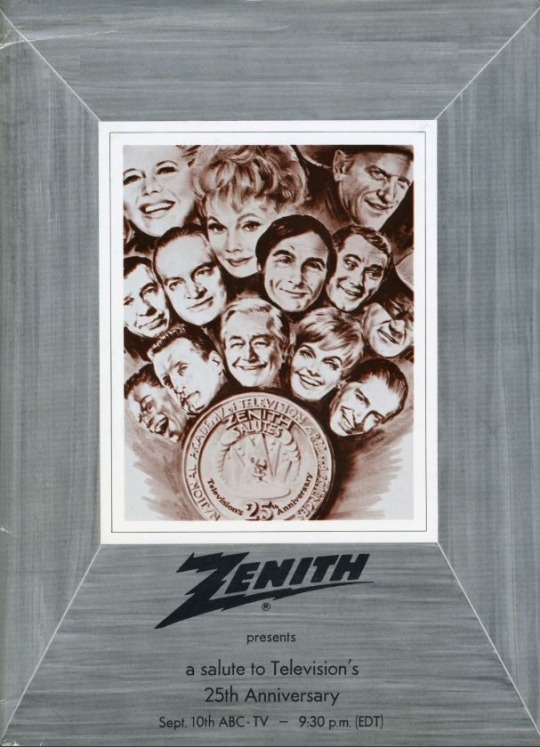
Produced & Directed by Marty Pasetta
Written by John Bradford, Lenny Weinrib, Bob Wells

Cast (in alphabetical order)
Judith Anderson, honoree accepting for “Hallmark Hall of Fame”
Russell Arms, performer “Hit Parade”
James Arness, honoree accepting for “Gunsmoke”
Lucille Ball, honoree
Milton Berle, honoree
Sid Caesar, honoree
George Chakiris, performer “Westerns” / “Crime Drama”
Maria Cole, honoree on behalf of her late husband, Nat King Cole
Edward M. Davis, honoree accepting for Jack Webb and “Dragnet”
Jimmy Durante, performer / presenter “Music and Variety”
Dave Garroway, honoree and presenter
Lorne Greene, honoree accepting for “Bonanza”
Florence Henderson, performer “How Sweet it Was”
Bob Hope, honoree
Snooky Lanson, performer “Hit Parade”
Gisele MacKenzie, performer “Hit Parade”
Dewey Murrow, honoree accepting for his brother, Edward R. Murrow
Harry Reasoner, presenter “News”
George C. Scott, presenter “Drama”
Rod Serling, presenter
Dinah Shore, honoree
Tom & Dick Smothers, performers
Ed Sullivan, honoree
Eileen Wilson, performer “Hit Parade”
Robert Young, presenter “Opening” / “Closing”
John Wayne, presenter “Westerns”
Efrem Zimbalist Jr., presenter “Crime Drama”
Dick Tufeld, Announcer
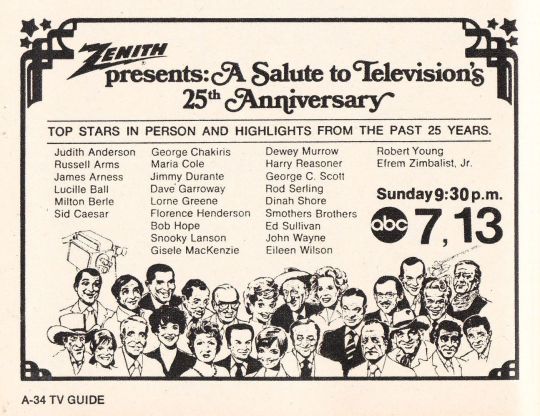
This was a 90-minute special on ABC TV. It was taped August 9 to August 12 in Los Angeles. It featured clips from show’s from television’s past.

Zenith was co-founded in 1918 by Ralph Matthews and Karl Hassel as Chicago Radio Labs. The name "Zenith" came from ZN'th, a contraction of its founders' ham radio call sign, 9ZN. The Zenith Radio Company was formally incorporated in 1923. LG Electronics acquired a controlling share of Zenith in 1995, becoming a wholly owned subsidiary in 1999. Zenith was the inventor of subscription television and the modern remote control, and the first to develop High-definition television (HDTV) in North America.
In his diaries, singer Perry Como mentions jetting to Las Vegas to appear on the show, but he is not in the cast nor is he mentioned as an honoree.
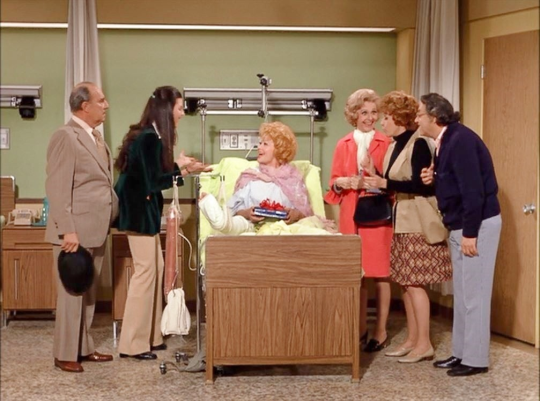
The next night, Monday, September 11, on CBS, “Here’s Lucy” presented its fifth season premiere “Lucy’s Big Break” (HL S5;E1).
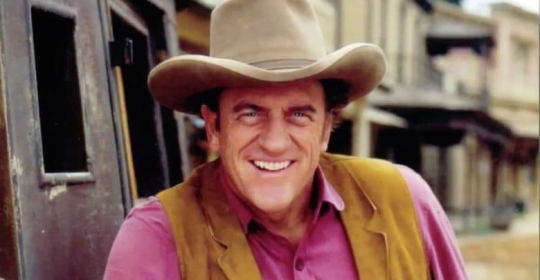
“Here’s Lucy’s” lead-in was the 18th season premiere of “Gunsmoke” starring James Arness.
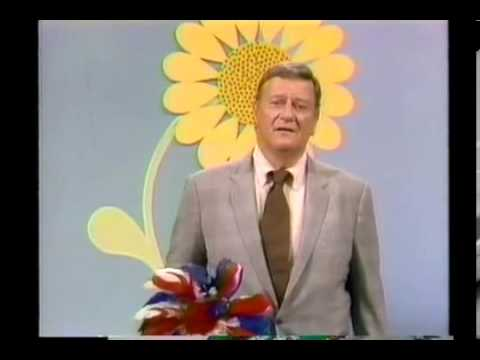
“Gunsmoke’s” competition on NBC was “Rowan and Martin’s Laugh-In” which that night started its sixth season with guest star John Wayne. This is very ironic, considering that this Zenith special features a promo that John Wayne did for “Gunsmoke” when it first premiered in 1955!
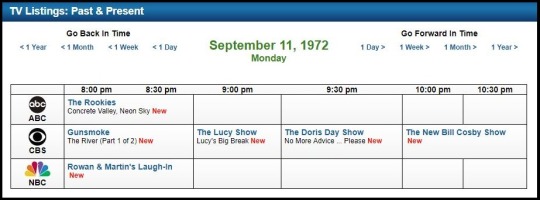
This was a busy night for television, with the series premiere of “The Rookies” (1972-76) on ABC. At 10pm CBS also presented the premiere of “The New Bill Cosby Show,” which lasted just one season.
The show begins with a boy named John Joyce (played by uncredited actors of various ages) who grew up watching television.
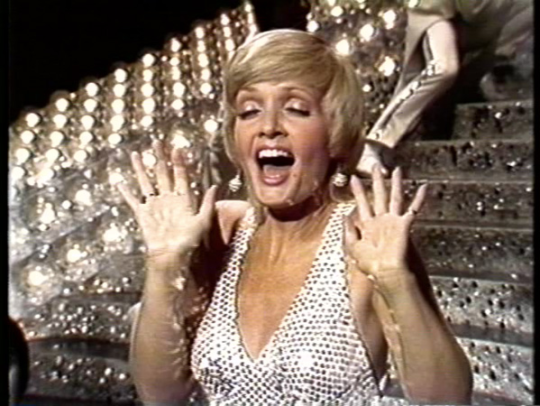
After the opening credits, Florence Henderson performs the seven-minute opening number “How Sweet It Was,” surrounded by dancers. The original song was written by Jack Elliott, Bob Wells and John Bradford. In a section devoted to children's shows, the dancers perform “The Mickey Mouse Club” theme, dressed in mouse ears and sweaters with names on them.

Robert Young (”Marcus Welby”) takes the stage to explain that the Academy of Television Arts and Sciences is also 25 years old and will be honoring a select group of people and programs who have made an impact, had popularity, proved longevity, and demonstrated substance. The recognition award is a silver medallion on a plaque.
A montage of clips from news footage of the Berlin Airlift, the Israeli War, the first Political Convention on TV, and the Kefauver Hearings, and the McCarthy Hearings, follows.
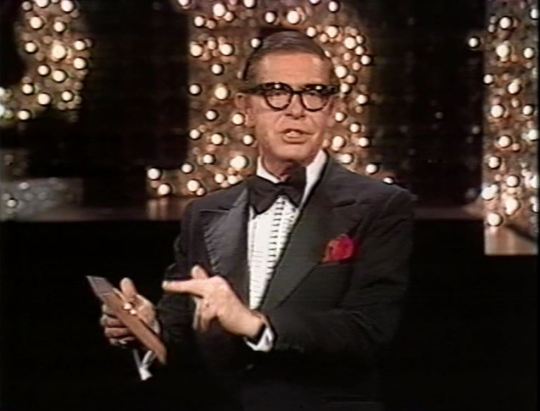
Young pays tribute to television's early comedians with clips of such comics as Jimmy Durante, Martin and Lewis, “The Honeymooners,” and and ending with clips from “Texaco Star Theatre” starring Milton Berle wearing various outrageous costumes.Berle is the first recipient of the medallion. He enters to thank the audience and briefly talk about his type of comedy. Berle claims to have done 641 hours of live television!
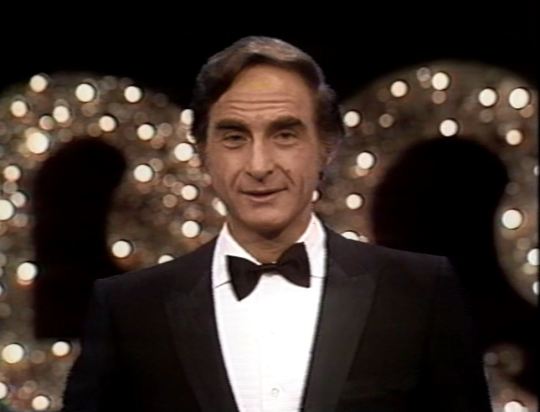
Berle closes by introducing a clip from “Your Show of Shows” starring Sid Caesar and Imogene Coca as figures on a Bavarian clock. Caesar takes the stage to thank the Academy for the medallion. His remarks are humble and brief.

After a commercial for Zenith Super Chromacolor, there is a tribute to TV dramas with a montage of clips from anthology shows like “The Alcoa Hour,” “Dupont Show of the Week,” “Westinghouse Studio One,” “The U.S. Steel Hour,” “Playhouse 90,” “Hallmark Hall of Fame,” “Goodyear Playhouse,” “Producer's Showcase,” and “Net Playhouse.” The clips feature actors like Robert Preston, Andy Griffith, Jackie Gleason, and Paul Newman.

George C. Scott enters to talk about the contributions of “The Hallmark Hall of Fame.” Clips from the show feature actors like Charlton Heston, Peter Ustinov, George C. Scott, and Dame Judith Anderson, who accepts a medallion on behalf of the show.

A salute to TV Westerns begins with a stylized Old West town with a handsome stranger (George Chakiris), riding into town on a white horse. Entering the saloon, he plays cards with a man in black, listens to Lily the dance hall girl, and then gets into a shoot out where (naturally) he is the only one left standing.
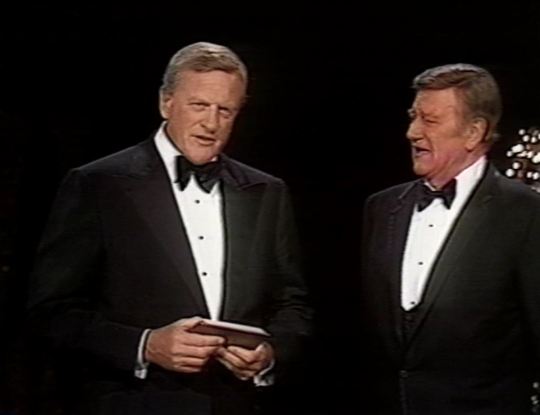
After the sketch, John Wayne introduces clips from westerns like “The Lone Ranger,” “Cheyenne, ” “Bonanza,” and “Gunsmoke.” James Arness, who played Marshall Dillon on “Gunsmoke,” joins Wayne onstage to receive a medallion on behalf of the show.
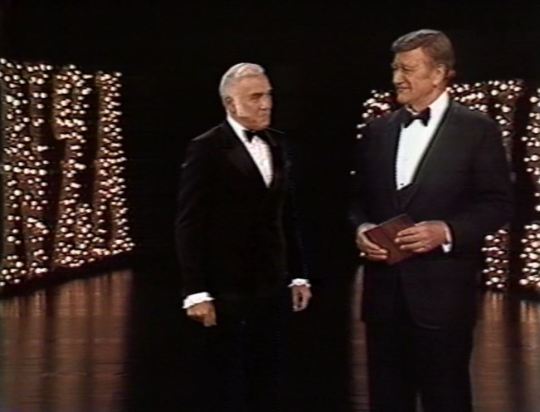
Lorne Greene then accepts a medallion on behalf of “Bonanza.”
A salute to TV crime dramas begins with a stylized city street with a handsome stranger (George Chakiris again), riding into town in a white sports car. The scenario deliberately mirrors the previous one for westerns. Entering the bar, he listens to Sally the burlesque dancer, and gets into a shoot out with a man in black where (naturally) he is the only one left standing.

After the sketch, Efrem Zimalist Jr. (“The F.B.I.”) introduces some ‘fast moving scenes’ from crime shows like “Hawaii Five-O” and (oddly) “Batman.” Zimbalist pays tribute to Jack Webb and the series “Dragnet.” Accepting the medallion on behalf of Webb is Los Angeles Police Commissioner Edward M. Davis.
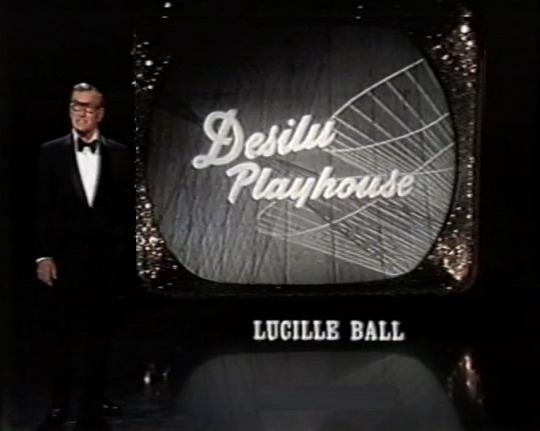
Dave Garroway (“Today”) tells us that there are 121 recipients of the silver anniversary medallion, and that there is no way a 90-minute program can adequately pay tribute them all. Behind him is a scroll of names and clips from the honorees, including Lucille Ball and “The Desilu Playhouse.” Interestingly, for the sake of continuity, all the clips are in black and white, even if a show was aired in color.
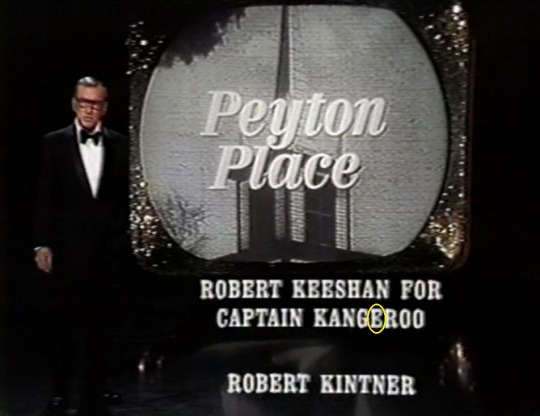
Oops! The list of honorees mis-spells “Captain Kangaroo” as “Captain Kangeroo.”
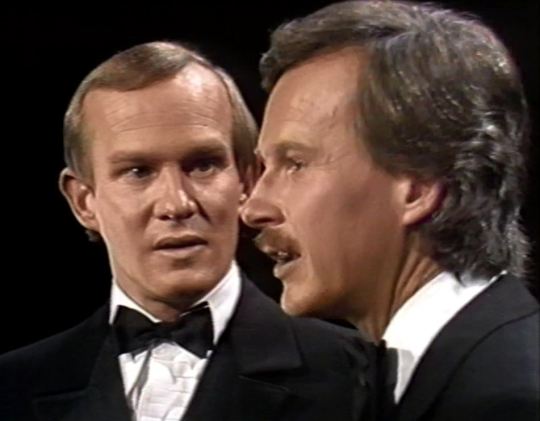
The Smothers Brothers, Tom and Dick, talk about television, although Tom has trouble not mentioning its many flaws, despite Dick's attempt to keep things positive.
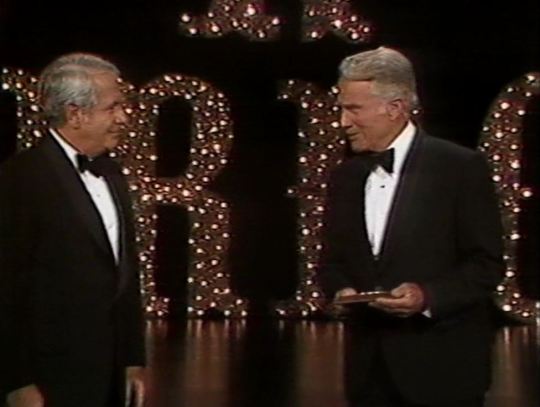
Harry Reasoner talks about television news and tributes Edward R. Murrow. Clips consist of Murrow interviewing such figures as Castro, Marilyn Monroe, and John F. Kennedy. Murrow died in 1965, so his brother Dewey Murrow accepts the medallion on his behalf.
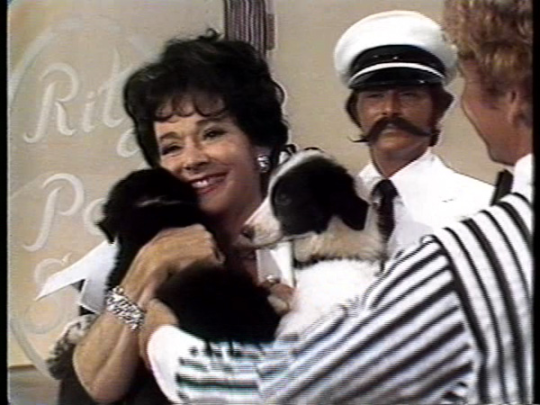
Leading off a tribute to music on television is presented in the style of “Your Hit Parade”:
#5 - “Shrimp Boats” sung by Eileen Wilson. It was written in 1951 by Paul Mason Howard and Paul Weston.
#3 - “(Why Did I Tell You I Was Going To) Shanghai” sung by Russell Arms. It was written in 1951 by Bob Hilliard and Milton De Lugg.
Extra - “Love is Sweeping the Country” performed by the Hit Parade Dancers. It was written by George and Ira Gershwin for the 1931 musical Of Thee I Sing.
#2 - “(How Much is That) Doggie in the Window?” sung by Giselle MacKenzie (above). It was written by Bob Merrill in 1952.
#1 - “This Ole House” sung by Snooky Lanson. It was written by Stuart Hamblen in 1954.
Curiously, there is no #4, perhaps for time limitations or because there are only four alumni of “Your Hit Parade” in the show.
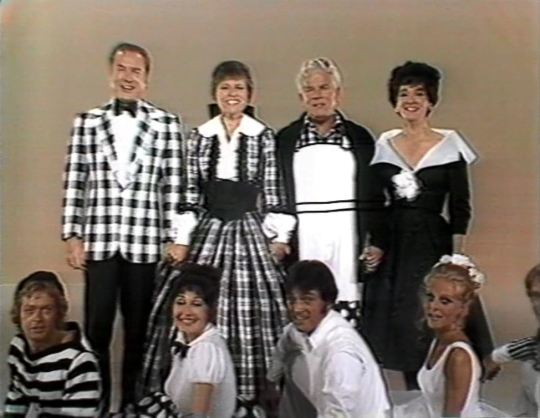
Closing the section, the group sings “So Long for a While,” the closing song of “Your Hit Parade” written by Hy Zaret.

Jimmy Durante enters at the end of the sequence to tribute Music and Variety on television. It begins with a montage that features Steve Allen, Liberace, Durante, Edgar Bergen, and Dinah Shore, who is the next honoree. Dinah talks about her work on “The Chevy Show.”
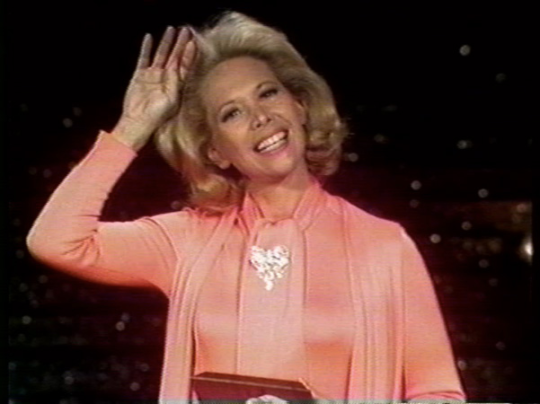
Dinah Shore: “We were live and our main motivation was fear!”
Shore then tributes the late Nat King Cole, and introduces Maria Cole, his widow. “The Nat King Cole Show” (1956) was the first television show starring a black man.
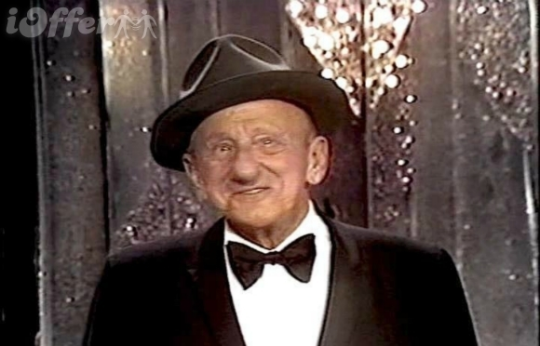
Durante returns and sings “September Song” by Kurt Weill and Maxwell Anderson for the 1938 musical Knickerbocker Holiday.
After a commercial, Rod Serling (“The Twilight Zone”) presents a medallion to 'Mr. Sunday Night' Ed Sullivan. Clips from “Toast of the Town” (aka “The Ed Sullivan Show”) feature Julie Andrews, the Beatles, Rocky Marciano, and President Eisenhower.
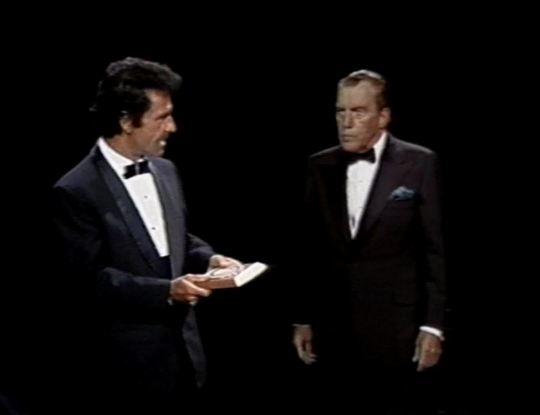
When Ed Sullivan enters to accept his medallion, it is apparent that he is not on the same stage with Serling, but has been inserted into the shot using special effects. When Serling hands him the award, the camera switches to a close-up to avoid the transfer.
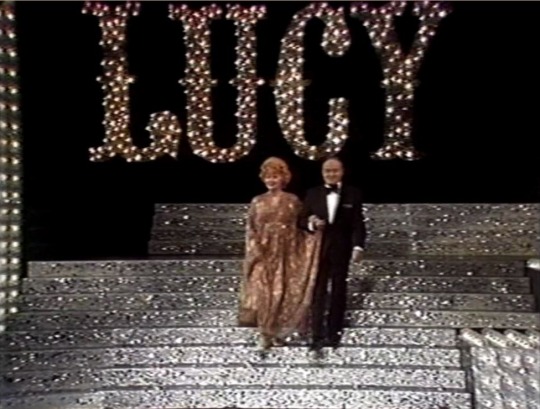
Serling also presents medallions to Lucille Ball and Bob Hope. A brief montage of clips from “I Love Lucy” and various Bob Hope specials follows. It includes scenes from “The Audition” (ILL S1;E6), “The Operetta” (ILL S2;E5), “Lucy Meets Harpo Marx” (ILL S4;E28). Interestingly, there are no clips of the two performing together.
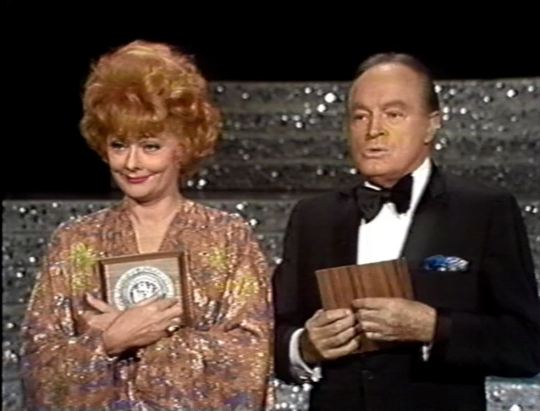
Once again, it is apparent that Serling is not on the same stage as Lucy and Bob, despite the fact that they address him as if he were there standing beside him. This time there is no special effect to imply they are together. Hope calls him the “spooky writer” and Lucy refers to Serling's voice on “headache commercials.” Hope and Ball exchange some friendly banter based on their age:
Lucy: “I just love watching 'The Late, Late Show'. Where else could I be 25 for 25 years?" Bob: “On your reruns. You know I'm kidding, Lucy. You're the most beautiful woman in Hollywood and you have been for many years.” Lucy: “That's quite a compliment considering you started as a stuntman for Francis X. Bushman.”
The show closes with the singers and dancers reprising “How Sweet It Was” and Robert Young returning to sum up television's progress and promise for the future. This time the clips behind him are in color. A montage of 'good nights' from various television shows plays under the credits.
This Date in Lucy History ~ September 10

“Lucy and Danny Thomas” (HL S6;E1) ~ September 10, 1974
#Zenith#Lucille Ball#Bob Hope#Here's Lucy#Danny Thomas#A Salute to Television's First 25 Years#Judith Anderson#Hallmark Hall of Fame#Robert Young#Russell Arms#Your Hit Parade#James Arness#Bonanza#Gunsmoke#Milton Berle#Texaco Star Theatre#George Chakiris#Sid Caesar#Your Show of Shows#I Love Lucy#Maria Cole#Nat King Cole#Dinah Shore#The Chevy Show#Edward M. Davis#Jimmy Durante#September Song#Dave Garroway#Lorne Greene#Florence Henderson
6 notes
·
View notes
Text
Star Trek and So Much More: The Breakout TV Season of 1966-67
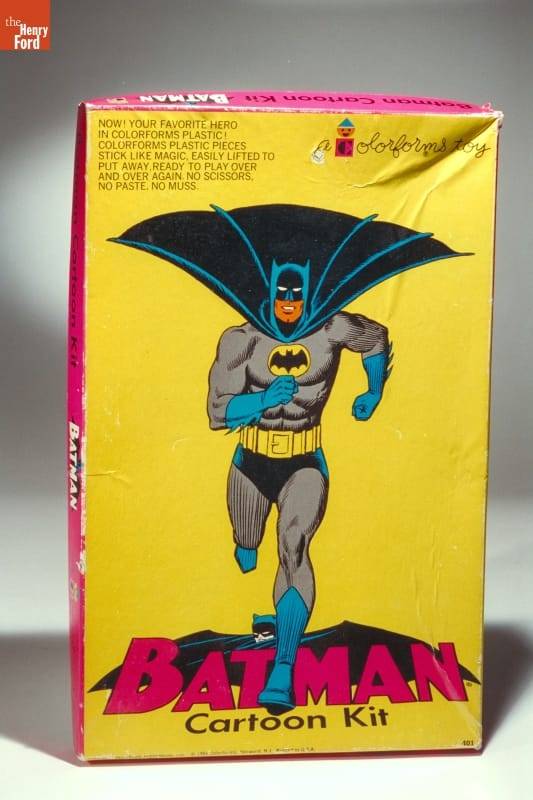
“Batman Cartoon Kit” Colorforms, 1966-68. THF 6651
It was the 1960s—the golden age of television. Some 95% of American homes boasted at least one TV. These were primarily black and white sets, as color TV was still out of the reach of many families. It’s hard to imagine now but there were only three channels at the time. Every year, the three networks (CBS, NBC, and ABC) vied for viewer ratings, shifting and changing shows and showtimes at two pivotal times during the television season—Fall and Winter.
As the Fall 1966 season unfolded, it became evident to TV viewers that something extraordinary was happening. Sure, there were the usual long-running sitcoms, like Green Acres, Petticoat Junction, and The Beverly Hillbillies. But change was in the wind. A new crop of programs emerged—colorful, fast-paced, poking fun at things that were supposed to be serious and exploring contemporary social issues.
Why the difference all of a sudden? Many of these shows were aimed at the youth audience, considered by this time an influential group of TV watchers. Others purposefully took advantage of the new color televisions. Sometimes show producers and creators were simply tired of the old formulas and wanted to break out of the box.
Let’s take a look at a few highlights from the 1966-67 TV season—starting with the staid and true and working up to the wild and wacky—and see what all the hubbub was about!
Walt Disney’s Wonderful World of Color (Sunday, 7:30-8:30 p.m., NBC)

Snow Globe, “The Wonderful World of Disney,” 1969-79. THF174650
On Sunday nights since 1954, millions of Americans had tuned in to watch Walt Disney host his TV show, with a changing array of animated and live-action features, nature specials, movie reruns, travelogues, programs about science and outer space, and—best of all—updates on Walt Disney’s theme park, Disneyland. Since 1961, this show had been broadcast in color.
The 1966-67 season was particularly memorable because Walt Disney tragically passed away on December 15, 1966. But since the episodes had been pre-recorded, there was Walt still hosting them until April 1967. Viewers found this both comforting and disconcerting. Finally, after April, Walt was dropped as the host and, eventually, the show was retitled The Wonderful World of Disney. It ran with solid ratings until the mid-1970s.
Bonanza (Sunday, 9:00-10:00 p.m., NBC)

“Ponderosa Ranch” Mug, ca. 1970. THF174648
Viewership was high on NBC on Sunday nights at 9:00, as Bonanza was one of the most popular TV shows of all time. Running for 14 seasons and 430 episodes, this series about the trials and tribulations of widower Ben Cartwright and his three sons on the Ponderosa Ranch was an immediate breakout hit when it premiered in 1959, amidst a plethora of more run-of-the-mill prime-time westerns. Its popularity was primarily due to its quirky characters and unconventional stories—including early attempts to confront social issues. It was the first major western to be filmed in color and was the top-rated show on TV from 1964 to 1968. Bonanza ran until 1973.
The Man from U.N.C.L.E. (Friday, 8:30-9:30, NBC)

“The Man from U.N.C.L.E.” lunchbox and thermos, 1966. THF92303
Premiering in September 1964, The Man from U.N.C.L.E. took full advantage of the popularity of the spy genre launched by the James Bond film series. In fact, early concepts for it were conceptualized by Bond creator Ian Fleming. In this series, Napoleon Solo (originally conceived as the lone star) and Russian agent Ilya Kuryakin (added in response to popular demand) teamed up as part of a secret international counterespionage and law enforcement agency called U.N.C.L.E. (United Network Command for Law and Enforcement). Solo and Kuryakin banded together with a global organization of other agents to fight THRUSH, an international organization that aimed to conquer the world.
During this, the Cold War era, it was groundbreaking for a show to portray a United States-Soviet Union pair of secret agents, as these two countries were ideologically at odds most of the time. The Man from U.N.C.L.E. was also known for its high-profile guest stars and—taking a cue from the Bond films—its clever gadgets. In 1966, this series won the Golden Globe for Best Television Program and, building upon its popularity, spun off into two related double-feature movies that year. Unfortunately, attempting to compete with lighter, campier programs of the era, the producers made a conscious effort to increase the level of humor—leading to a severe ratings drop. Although the serious plot lines were soon reinstated, the ratings never recovered. The Man from U.N.C.L.E. was canceled in January 1968.
I Spy (Wednesday 10:00-11:00, NBC)
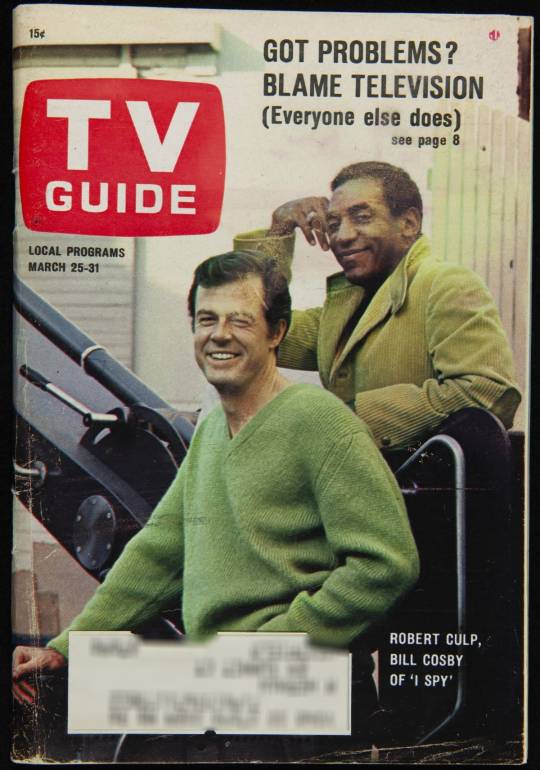
TV Guide featuring “I Spy” characters Robert Culp and Bill Cosby on cover, March 25-31, 1967. THF275655
One series that never opted for campy was I Spy, which starred Bill Cosby and Robert Culp playing two U.S. intelligence agents traveling undercover as international “tennis bums.” This series, which premiered in 1965, was also inspired by the James Bond film series and remained a fixture in the secret agent/espionage genre until cancelled in April 1968. I Spy, additionally a leader in the buddy genre, broke new ground as the first American TV drama series to feature a black actor in a lead role. It was also unusual in its use of exotic locations—much like the James Bond films—when shows like The Man from U.N.C.L.E. were completely filmed on a studio backlot.
I Spy offered hip banter between the two stars and some humor, but it focused primarily on the grittier side of the espionage business, sometimes even ending on a somber note. The success of this series was attributed to the strong chemistry between Culp and Cosby. Cosby’s presence was never called out in the way that black stars and co-stars were made a big deal of on later TV programs like Julia (1968) and Room 222 (1969).
Get Smart (Saturday, 8:30-9:00 NBC)

“Get Smart” Lunchbox, 1966. THF92304
Premiering in September 1965, Get Smart was a comedy that satirized virtually everything considered serious and sacred in the James Bond films and such TV shows as I Spy and The Man from U.N.C.L.E. Created by comic writers Mel Brooks and Buck Henry as a response to the grim seriousness of the Cold War spy genre, it starred bumbling Secret Agent 86—otherwise known as Maxwell “Max” Smart, along with supporting characters, female Agent 99 and the Chief. These characters worked for CONTROL, a secret U.S. government counterintelligence agency, against KAOS, “an international organization of evil.” Brooks and Henry also poked fun at this genre’s use of high-tech spy gadgets (Max’s shoe phone perhaps being the most memorable), world takeover plots, and enemy agents. Somehow, despite serious mess-ups in every episode, Maxwell Smart always emerged victorious in the end.
Get Smart was considered groundbreaking for broadening the parameters of TV sitcoms but was especially known for catchphrases like “Would you believe…” and “Sorry about that, Chief.” Despite a declining interest in the secret-agent genre, Get Smart’s talented writers attempted to keep it fresh until it was finally cancelled in May 1970.
Batman (Wednesday and Thursday, 7:30-8:00, ABC)

Toy Batmobile, 1966-69. THF174647
Bursting onto the scene in January 1966, Batman became an instant hit and took the country by storm. Batmania was in full swing by the Fall 1966-67 TV season. The series, based upon the DC comic book of the same name, featured the Caped Crusader (millionaire Bruce Wayne in his alter-ego of Batman) and the Boy Wonder (his young ward Dick Grayson in his alter-ego of Robin). These two crime-fighting heroes defended Gotham City from a variety of evil villains. It aired twice weekly, with most stories leaving viewers hanging in suspense the first night until they tuned in the second night.
This show successfully captured the youth audience, with its campy style, upbeat theme music, and tongue-in-cheek humor. Despite the fact that it verged on being a sitcom, the producers wisely left out the laugh track, reinforcing the seriousness with which the characters seemed to take the often absurd and wildly improbable situations in which they found themselves. The filming simulated a surreal comic-book quality, with characters and situations shot at high and low angles, with bright splashy colors and with sound effects, like Pow, Bam, and Zonk, appearing as words splashed across the action sequences on screen. The series was also replete with numerous gadgets and over-the-top props, with the Batmobile undoubtedly most memorable. Batman ran until March 1968, experiencing a significant ratings drop after its initial novelty faded.
Lost in Space (Wednesday 7:30-8:30, CBS)

“Lost in Space” Lunchbox and Thermos, 1967. THF92298
Loosely based upon the story of the Swiss Family Robinson, this TV series depicted the adventures of the Robinson family, a pioneering family of space colonists who struggled to survive in the depths of space in the futuristic year of 1997—as the United States was gearing up to colonize space due to overpopulation. But the family’s mission was sabotaged, forcing the crew members to crash-land on a strange planet and leaving them lost in space.
The show had premiered in September 1965 as a serious science fiction series about space exploration and a family searching to find a new place for humans to dwell. But, in January 1966, pitted against Batman’s time slot, Lost in Space producers attempted to imitate Batman’s campiness with ever-more-outrageous villains, brightly colored outfits, and over-the-top action. The plots increasingly featured Robby the Robot and the evil Dr. Zachary Smith. Viewers and actors alike strongly disapproved of this shift. The show lingered on until March 1968.
The Monkees (Monday, 7:30-8:00, NBC)
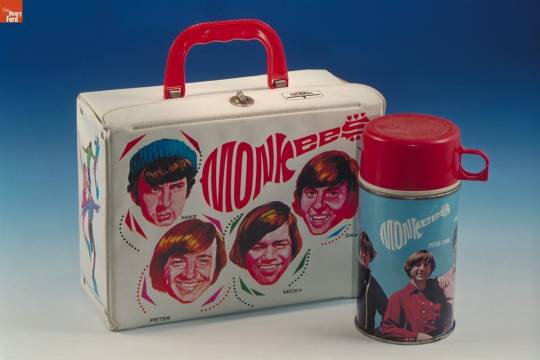
“Monkees” Lunchbox and Thermos, 1967. THF92313
Where other shows might have been lighthearted, campy, or tongue-in-cheek, The Monkees at times verged on pure anarchy. This series, which premiered on September 12, 1966, led off NBC’s prime-time programming every Monday night. It lasted only two seasons but during that time, its star shone brightly. The Monkees followed the experiences of four young men trying to make a name for themselves as a rock ‘n’ roll band, often finding themselves in strange, even bizarre, circumstances while searching for their big break. Aimed directly at the youth audience, the band members were characterized as heroes down on their luck while the adults were consistently depicted as the “heavies.”
The Beatles’ films A Hard Day’s Night and Help! inspired producers Bob Rafelson and Bert Schneider to create not only a show about a rock ‘n’ roll band but also to adapt a loose narrative structure (each member of the Monkees was trained in improvisational acting techniques at the outset of the show) and the musical sequences or “romps” that appeared each week. The series built a reputation for its innovative use of avant-garde filming techniques like quick jump cuts and breaking the fourth wall (that is, having the characters directly address the TV viewers). A well-oiled marketing machine behind the show also ensured that strong tie-ins were maintained with teen magazines, merchandise, and live concerts.
The Monkees won the Emmy for best comedy series during its first, the 1966-67, season. However, backlash was inevitable among critics and older teenagers when the Monkees admitted that they did not play their own instruments—although they clearly played them in their live concerts and, in fact, eventually had a falling-out with network executives about this very issue. Though the show was cancelled in 1968, it experienced a huge revival among younger audiences through Saturday morning reruns and especially with the 1986 MTV Monkees Marathon. Remaining band members Micky Dolenz and Mike Nesmith still attract large audiences of intergenerational fans at their live concerts, while reruns of their TV shows continue to draw new audiences.
Star Trek (Thursday, 8:30-9:30 NBC)

“Star Trek” lunchbox, 1968. THF92299
When Star Trek premiered on September 8, 1966, science fiction shows were not very advanced—or even thought of very highly. Star Trek’s closest competitor, Lost in Space, offered only shallow plots, one-dimensional characters, and fake sets. No one could imagine at the time that this rather low-key show would become one of the biggest, longest-running, and highest-grossing media franchises of all time. This series traced the interstellar adventures of Captain James T. Kirk and his crew aboard the United Federation of Planets’ starship Enterprise, on a five-year mission “to explore strange new worlds, to seek out new life and new civilizations, to boldly go where no man has gone before.”
Creator Gene Roddenberry, aiming the show at the youth audience, wanted to combine suspenseful adventure stories with morality tales reflecting contemporary life and social issues. So, to get by network scrutiny, he set the premise of the show in an imaginary future. With the freedom to experiment, he put in place one of TV’s first multiracial and multicultural casts and was able to explore through different episodes some of the most relevant political and social allegories on TV at the time. The stories were also considered exceptionally high quality for that era, involving believable characters with which viewers could both identify and sympathize. Unlike the gloomy predictions of most science fiction writings of the time, Roddenberry hoped that the futuristic utopia he created on Star Trek would give young people hope, that it would empower them to create a better future for themselves someday. Star Trek, with only modest ratings, lasted only three seasons. But it would go on to become a cult classic.
The Smothers Brothers Comedy Hour (Sunday, 9:00-10:00 p.m. beginning February 1967, CBS)
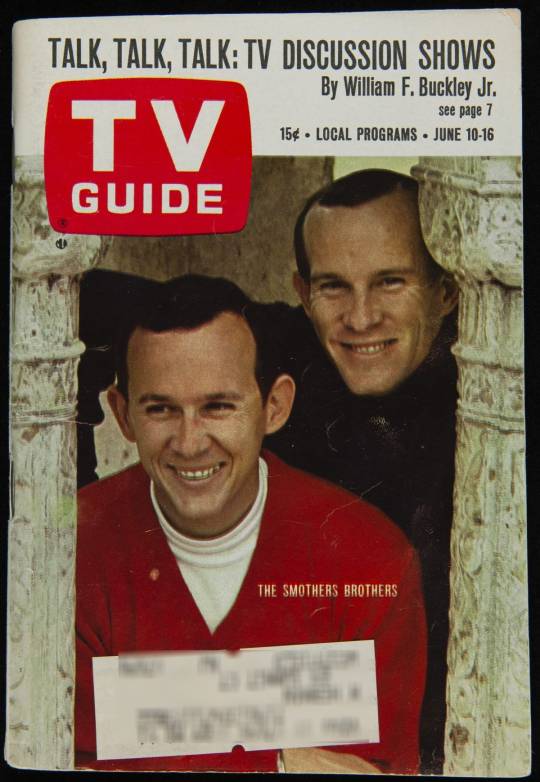
TV Guide featuring The Smothers Brothers on cover, June 10-16, 1967. THF275657
In Fall 1966, The Garry Moore Show, a variety show on CBS hosted by the aging radio and TV star, was no match when pitted against Bonanza—even with this, its first season in color. Network executives, at their wit’s end to try to attract viewership, decided the only way they could come up with a quick replacement was to substitute another variety show. In desperation, they landed on a simple variety series featuring the soft-spoken, clean-cut, non-threatening folk-music-playing Smothers Brothers. Considered a “young act,” an added bonus was that their show might capture the coveted youth audience. Little did they know what they were in for.
As the show evolved, the brothers not only became more politicized themselves but felt that they owed it to their young viewers to increase the show’s relevance, boldly addressing overtly divisive political and social issues. Their staff of young writers was only too happy to comply. Unfortunately, as a result, the brothers were continually at odds with the network censors until the show was finally cancelled after three seasons. In its continual conflicts with network executives, The Smothers Brothers Comedy Hour turned the variety show genre on its ear and paved the way for Rowan & Martin’s Laugh-In (1968) and, in pushing TV’s all-out rebellion against the status quo, led an explosive charge that resulted in 1970s shows like All in the Family (1971).
These are but a few highlights from the 1966-67 TV season. Some say that this was the greatest television season ever, a clear indication that TV had finally come of age. Because of shows like these, television would certainly never be the same again. And, come to think of it, neither would we!
Donna Braden, Curator of Public Life, was 13 years old during that memorable TV season and proudly wears her fan club button to every Monkees concert she still attends.
#1 Ford Daily | Đại lý – Showroom ủy quyền Ford Việt Nam 2019 Ford Daily là showroom, đại lý Ford lớn nhất Việt Nam: Chuyên phân phối xe ô tô FORD như: EcoSport ✅ Everest ✅ Explorer ✅ Focus ✅ Ranger… [email protected] 6A Đường Trần Hưng Đạo, Phường Phạm Ngũ Lão, Quận 1, Hồ Chí Minh 711240 0901333373 https://forddaily.com/ https://forddaily.com/xe/ https://forddaily.com/dai-ly/ https://forddaily.com/bang-gia/ https://forddaily.com/tra-gop/ #forddaily #dailyfordhcm #fordshowroomhcm https://www.google.com/maps/place/Ford+Daily/@10.7693359,106.696211,15z/data=!4m5!3m4!1s0x0:0x1f188a05d927f4ff!8m2!3d10.7693359!4d106.696211
1 note
·
View note
Photo

Epstein and the American Lie Machine Let’s begin with why Jeffrey Epstein is such big news. It was Epstein that introduced Melania to Donald, it is Epstein that is named in the infamous “Jane Doe” lawsuit as sexually assaulting a 12 year old girl with full participation by Donald Trump. This is why the Epstein story dominates American news, it is seen as an opening to bring down Donald Trump. The Epstein story touches everywhere, discredits American justice, American media, reaches into the White House, perhaps through numerous occupants and eventually settles in, a continuing mystery, still protected by a controlled media as it leads us to not one but 20 billionaires, a secret society tied to Epstein, that represents the power of Israel over the governments of the US, Britain and Canada. This makes solving the Epstein mystery key to understanding events that spiral closer and closer toward a war likely to dwarf the conflicts after 9/11. What is the real story? First of all, sex with children is nothing new in America. Child sex was the norm when the Pilgrims landed on Plymouth Rock in 1620 and little changed other than it becoming a convenient tool to smear political opponents. For two centuries, girls as young as 12 were regularly married off, sometimes forcibly, to men as old as 70 while others were sold into slavery to work in the mills or join the endless hordes serving in America’s brothels. Every town and village in America still has brothels, usually rooms or camping trailers behind adult book stores or massage parlors. Similar services are available at the finest hotels in New York, Washington and elsewhere, just ask the concierge. Hypocrisy isn’t uniquely American but it flourishes in America wrapped in the flag and bible as no place else on earth. For those unfamiliar with the Epstein story, it all began in 2003 with a writer for Vanity Fair, Vicky Ward, wrote a story about a mysterious individual who claimed to be a billionaire, name Epstein. Epstein had little formal education but for reasons unknown landed a prestigious teaching job and then moved on to the most corrupt Ponzi scheme operations on Wall Street. Behind all this was Epstein’s ever more colorful history of raping children and doing so allegedly aided by Ghislaine Maxwell, daughter of the infamous Robert Maxwell, British media mogul and alleged Mossad blackmailer who was murdered in 1991. Our sources say Epstein and Maxwell operated from a fabulous New York brownstone belonging to a top retail clothing industry leader and Israeli proponent. The nature of that relationship, certainly “deeply personal” or more, is banned from the US media. Suffice it to say Epstein was gifted the property in New York rumored to be worth well over $50 million and, moreover, most of Epstein’s public wealth is said to come from investing funds for that same client, the one with whom Epstein had that very personal relationship, a very very close male to male friendship. For two decades, even longer, Epstein, Maxwell and others including but not limited to Donald Trump, attorney Alan Dershowitz and even Prince Andrew were accused of raping children and building a network that enticed school girls into their web to be subjected to every imaginable perversity. All the while, the media reported little or nothing of this despite endless criminal complaints and civil suits. Evidence now shows that witnesses were paid off, police bullied by a large Washington law firm and one foreign intelligence agency actually blocked a 2008 prosecution, which recently led to the resignation of US Secretary of Labor, Andrew Acosta. Acosta claims he ordered a “hand slap” prosecution of Epstein for numerous charges of child rape because Epstein worked for an intelligence agency, albeit not an American intelligence agency. We understand that Acosta made this assumption as Epstein’s probable co-defendant, Ghislaine Maxwell, has long been reputed to be a high-ranking Mossad officer. However, there is no evidence to confirm this or that Epstein and Maxwell had been blackmailing members of congress, Supreme Court justices and “captains of industry” for decades. Even still, these rumors and allegations are repeated endlessly. What is important to note, however, that until days ago, the Epstein story was taboo for the American press. You see, Epstein knew “everyone,” Benjamin Netanyahu, Rupert Murdoch, Mick Jagger, Donald Trump, rumored to be a regular companion, certainly former President Bill Clinton and almost all of Europe’s “trash” nobility. From the Rupert Murdoch owned New York Post, dated July 15, 2015: “Epstein, who was an investor in a Manhattan modeling venture, has been accused by prosecutors of using his connections to the modeling company to ‘audition’ girls to give him massages that often ended up in sexual abuse. ‘Over the years, it seems Epstein relied on … [the] modeling business to source underage girls for sex,’ writes Conchita Sarnoff, an investigative reporter, in her book ‘Trafficking.’ A former Manhattan-based model agent, who spoke on the condition of anonymity, also alleged an Epstein-Victoria’s Secret pimp pipeline. (Victoria’s Secret is a chain of stores owned by Israeli American billionaire Leslie Wexner, allegedly one of the architects of the US invasion of Iraq in 2003. In other court filings, Maxwell and Epstein are accused of raping underage girls at Wexner’s Ohio home, victims who were held prisoner by Wexner’s security personnel, according to written testimony. Wexner heads Mega, a group of 20 Israeli American billionaires who fund Israel’s lobbying effort in support of military action against Muslim nations.) ‘He [Epstein] portrayed himself as the back door to get a girl into Victoria’s Secret. Some of those girls got in,’ he said. Another Manhattan model entrepreneur told The Post that Maxwell (alleged child rapist and Mossad blackmailer) was a constant fixture at Victoria’s Secret events. ‘They were always these really trashy shows full of rich men in the audience,’ he said. ‘Ghislaine acted as the kind of Nazi guard, telling everyone where they were sitting in the audience and that she had new ‘pop tarts,’ which is what she called the young models.’ (Ghislaine Maxwell has been accused of sexually assaulting two children, both female, in court filings.)’” The national security implications for the United States here are endless. First of all, we have a first lady in the White House, or at least there for some public occasions, who has some affiliation with Epstein and may have, herself, been victimized. This could be used to influence American policy in so many ways and yet nothing is asked, indications of a high level coverup. Then we have Acosta, the now disgraced former US Attorney and highly unqualified Secretary of Labor who may have been named to a cabinet post to buy his silence on Epstein. Only now does he tell us that he was threatened personally and gave Epstein a “sweetheart deal” because Epstein was a “spy.” Problem being, Epstein was probably a spy against the US, not “for” the US. Tied to this story, of course, is where we can follow the money, into the biggest names in American business and directly to the highest levels of AIPAC (American Israeli Public Affairs Council) and ADL (Anti-Defamation League), organizations long cited and even investigated for actions damaging to the US, actions done “in agency” for a foreign government. All the while this goes on, the same names, these same billions, this same influence, is pushing the US toward war with Iran. Sadly, while the media looks for a way to embarrass the president or first lady, the real problem may well be a bribery, blackmail and a spy ring that is pushing the world to the brink of destruction.
0 notes
Text
‘Saga,’ Sonny Liew, Jill Thompson take home 2017 Eisner Awards
Sonny Liew, Jill Thompson and the team behind Saga all took home multiple awards last night at the 28th annual Will Eisner Comic Industry Awards at Comic-Con International in San Diego.
Saga took home four awards, including Best Continuing Series and Best Writer for Brian K. Vaughan, while artist Fiona Staples won Best Cover Artist and Best Penciller/Inker. Liew ‘s awards for his graphic novel, The Art of Charlie Chan Hock Chye, included Best Writer/Artist, Best U.S. Edition of International Material—Asia, and Best Publication Design. And Jill Thompson was recognized three times: for Best Single Issue/One-Shot for her work on Beast of Burden: What the Cat Dragged In, Best Graphic Album—New for Wonder Woman: The True Amazon and Best Painter/Multimedia Artist.
Several comics legends were also honored at the ceremony. Jack Kirby and William Messner-Loebs both received the Bill Finger Excellence in Comics Writing Award, while Walt Simonson, Jim Starlin, Gilbert and Jaime Hernandez, George Perez, Milt Gross, H.G. Peter, Antonio Prohias and Dori Seda were all inducted into the Hall of Fame.
The Bob Clampett Humanitarian Award, created to honor those people in comics and the popular arts who have worked to help others, went to Joe Ferrara, for his work in prostate cancer awareness, and Mark Andreyko for curating the Love Is Love anthology after the Pulse nightclub shooting. Love is Love also won for best anthology.
Other awards presented at the ceremony include the Will Eisner Spirit of Retailer Award, which went to Comicazi in Somerville, Massachusetts, and the Russ Manning Promising Newcomer Award, which wnet to Anne Szabla, writer/artist of Bird-Boy.
Here’s the complete list of all nominees, with the winners bolded:
Best Short Story “The Comics Wedding of the Century,” by Simon Hanselmann, in We Told You So: Comics as Art (Fantagraphics) “The Dark Nothing,” by Jordan Crane, in Uptight #5 (Fantagraphics) “Good Boy,” by Tom King and David Finch, in Batman Annual #1 (DC) “Monday,” by W. Maxwell Prince and John Amor, in One Week in the Library (Image) “Mostly Saturn,” by Michael DeForge, in Island Magazine #8 (Image) “Shrine of the Monkey God!” by Kim Deitch, in Kramers Ergot 9 (Fantagraphics)
Best Single Issue/One-Shot Babybel Wax Bodysuit, by Eric Kostiuk Williams (Retrofit/Big Planet) Beasts of Burden: What the Cat Dragged In, by Evan Dorkin, Sarah Dyer, and Jill Thompson (Dark Horse) Blammo #9, by Noah Van Sciver (Kilgore Books) Criminal 10th Anniversary Special, by Ed Brubaker and Sean Phillips (Image) Sir Alfred #3, by Tim Hensley (Pigeon Press) Your Black Friend, by Ben Passmore (Silver Sprocket)
Best Continuing Series Astro City, by Kurt Busiek and Brent Anderson (Vertigo/DC) Kill or Be Killed, by Ed Brubaker and Sean Phillips (Image) The Mighty Thor, by Jason Aaron and Russell Dauterman (Marvel) Paper Girls, by Brian K. Vaughan and Cliff Chiang (Image) Saga, by Brian K. Vaughan and Fiona Staples (Image)
Best Limited Series Archangel, by William Gibson, Michael St. John Smith, Butch Guice, and Tom Palmer (IDW) Briggs Land, by Brian Wood and Mack Chater (Dark Horse) Han Solo, by Marjorie Liu and Mark Brooks (Marvel) Kim and Kim, by Magdalene Visaggio and Eva Cabrera (Black Mask) The Vision, by Tom King and Gabriel Walta (Marvel) We Stand on Guard, by Brian K. Vaughan and Steve Skroce (Image)
Best New Series Black Hammer, by Jeff Lemire and Dean Ormston (Dark Horse) Clean Room, by Gail Simone and Jon Davis-Hunt (Vertigo/DC) Deathstroke: Rebirth, by Christopher Priest, Carlo Pagulayan, et al. (DC) Faith, by Jody Houser, Pere Pérez, and Marguerite Sauvage (Valiant) Mockingbird, by Chelsea Cain and Kate Niemczyk (Marvel)
Best Publication for Early Readers (up to age 8) Ape and Armadillo Take Over the World, by James Sturm (Toon) Burt’s Way Home, by John Martz (Koyama) The Creeps, Book 2: The Trolls Will Feast! by Chris Schweizer (Abrams) I’m Grumpy (My First Comics), by Jennifer L. Holm and Matthew Holm (Random House Books for Young Readers) Narwhal: Unicorn of the Sea, by Ben Clanton (Tundra)
Best Publication for Kids (ages 9-12) The Drawing Lesson, by Mark Crilley (Ten Speed Press) Ghosts, by Raina Telgemeier (Scholastic) Hilda and the Stone Forest, by Luke Pearson (Flying Eye Books) Rikki, adapted by Norm Harper and Matthew Foltz-Gray (Karate Petshop) Science Comics: Dinosaurs, by MK Reed and Joe Flood (First Second)
Best Publication for Teens (ages 13-17) Bad Machinery, vol. 5: The Case of the Fire Inside, by John Allison (Oni) Batgirl, by Hope Larson and Rafael Albuquerque (DC) Jughead, by Chip Zdarsky, Ryan North, Erica Henderson, and Derek Charm (Archie) Monstress, by Marjorie Liu and Sana Takeda (Image) Trish Trash: Roller Girl of Mars, by Jessica Abel (Papercutz/Super Genius) The Unbeatable Squirrel Girl, by Ryan North and Erica Henderson (Marvel)
Best Humor Publication The Further Fattening Adventures of Pudge, Girl Blimp, by Lee Marrs (Marrs Books) Hot Dog Taste Test, by Lisa Hanawalt (Drawn & Quarterly) Jughead, by Chip Zdarsky, Ryan North, Erica Henderson, and Derek Charm (Archie) Man, I Hate Cursive, by Jim Benton (Andrews McMeel) Yuge! 30 Years of Doonesbury on Trump, by G. B. Trudeau (Andrews McMeel)
Best Anthology Baltic Comics Anthology š! #26: dADa, edited by David Schilter and Sanita Muizniece (kuš!) Island Magazine, edited by Brandon Graham and Emma Rios (Image) Kramers Ergot 9, edited by Sammy Harkham (Fantagraphics) Love Is Love, edited by Marc Andreyko (IDW/DC) Spanish Fever: Stories by the New Spanish Cartoonists, edited by Santiago Garcia (Fantagraphics)
Best Reality-Based Work Dark Night: A True Batman Story, by Paul Dini and Eduardo Risso (Vertigo/DC) Glenn Gould: A Life Off Tempo, by Sandrine Revel (NBM) March (Book Three), by John Lewis, Andrew Aydin, and Nate Powell (Top Shelf) Rosalie Lightning: A Graphic Memoir, by Tom Hart (St. Martin’s) Tetris: The Games People Play, by Box Brown (First Second)
Best Graphic Album—New The Art of Charlie Chan Hock Chye, by Sonny Liew (Pantheon) Black Dog: The Dreams of Paul Nash, by Dave McKean (Dark Horse) Exits, by Daryl Seitchik (Koyama) Mooncop, by Tom Gauld (Drawn & Quarterly) Patience, by Daniel Clowes (Fantagraphics) Wonder Woman: The True Amazon by Jill Thompson (DC Comics)
Best Graphic Album—Reprint Demon, by Jason Shiga (First Second) Incomplete Works, by Dylan Horrocks (Alternative) Last Look, by Charles Burns (Pantheon) Meat Cake Bible, by Dame Darcy (Fantagraphics) Megg and Mogg in Amsterdam and Other Stories, by Simon Hanselmann (Fantagraphics) She’s Not into Poetry, by Tom Hart (Alternative)
Best U.S. Edition of International Material Equinoxes, by Cyril Pedrosa, translated by Joe Johnson (NBM) Irmina, by Barbara Yelin, translated by Michael Waaler (SelfMadeHero) Love: The Lion, by Frédéric Brémaud and Federico Bertolucci (Magnetic) Moebius Library: The World of Edena, by Jean “Moebius” Giraud et al. (Dark Horse) Wrinkles, by Paco Roca, translated by Erica Mena (Fantagraphics)
Best U.S. Edition of International Material—Asia The Art of Charlie Chan Hock Chye, by Sonny Liew (Pantheon) Goodnight Punpun, vols. 1–4, by Inio Asano, translated by JN PRoductions (VIZ Media) orange: The Complete Collection, vols. 1–2, by Ichigo Takano, translated by Amber Tamosaitis, adaptation by Shannon Fay (Seven Seas) The Osamu Tezuka Story: A Life in Manga and Anime, by Toshio Ban and Tezuka Productions, translated by Frederik L. Schodt (Stone Bridge Press) Princess Jellyfish, vols. 1–3 by Akiko Higashimura, translated by Sarah Alys Lindholm (Kodansha) Wandering Island, vol. 1, by Kenji Tsuruta, translated by Dana Lewis (Dark Horse)
Best Archival Collection/Project—Strips (at least 20 years old) Almost Completely Baxter: New and Selected Blurtings, by Glen Baxter (NYR Comics) Barnaby, vol. 3, by Crockett Johnson, edited by Philip Nel and Eric Reynolds (Fantagraphics) Chester Gould’s Dick Tracy, Colorful Cases of the 1930s, edited by Peter Maresca (Sunday Press) The Realist Cartoons, edited by Paul Krassner and Ethan Persoff (Fantagraphics) Walt & Skeezix 1931–1932, by Frank King, edited by Jeet Heer and Chris Ware (Drawn & Quarterly)
Best Archival Collection/Project—Comic Books (at least 20 Years Old) The Complete Neat Stuff, by Peter Bagge, edited by Eric Reynolds (Fantagraphics) The Complete Wimmen’s Comix, edited by Trina Robbins (Fantagraphics) Fables and Funnies, by Walt Kelly, compiled by David W. Tosh (Dark Horse) Trump: The Complete Collection, by Harvey Kurtzman et al., edited by Denis Kitchen and John Lind (Dark Horse) U.S.S. Stevens: The Collected Stories, by Sam Glanzman, edited by Drew Ford (Dover)
Best Writer Ed Brubaker, Criminal 10th Anniversary Special, Kill or Be Killed, Velvet (Image) Kurt Busiek, Astro City (Vertigo/DC) Chelsea Cain, Mockingbird (Marvel) Max Landis, Green Valley (Image/Skybound), Superman: American Alien (DC) Jeff Lemire, Black Hammer (Dark Horse); Descender, Plutona (Image); Bloodshot Reborn (Valiant) Brian K. Vaughan, Paper Girls, Saga, We Stand On Guard (Image)
Best Writer/Artist Jessica Abel, Trish Trash: Roller Girl of Mars (Papercutz/Super Genius) Box Brown, Tetris: The Games People Play (First Second) Tom Gauld, Mooncop (Drawn & Quarterly) Tom Hart, Rosalie Lightning: A Graphic Memoir (St. Martin’s) Sonny Liew, The Art of Charlie Chan Hock Chye (Pantheon)
Best Penciller/Inker or Penciller/Inker Team Mark Brooks, Han Solo (Marvel) Dan Mora, Klaus (BOOM!) Greg Ruth, Indeh (Grand Central Publishing) Francois Schuiten, The Theory of the Grain of Sand (IDW) Fiona Staples, Saga (Image) Brian Stelfreeze, Black Panther (Marvel)
Best Painter/Multimedia Artist (interior art) Federico Bertolucci, Love: The Lion (Magnetic) Brecht Evens, Panther (Drawn & Quarterly) Manuele Fior, 5,000 km per Second (Fantagraphics) Dave McKean, Black Dog (Dark Horse) Sana Takeda, Monstress (Image) Jill Thompson, Wonder Woman: The True Amazon (DC); Beasts of Burden: What the Cat Dragged In (Dark Horse)
Best Cover Artist (for multiple covers) Mike Del Mundo, Avengers, Carnage, Mosaic, The Vision (Marvel) David Mack, Abe Sapien, BPRD Hell on Earth, Fight Club 2, Hellboy and the BPRD 1953 (Dark Horse) Sean Phillips, Criminal 10th Anniversary Special, Kill or Be Killed (Image) Fiona Staples, Saga (Image) Sana Takeda, Monstress (Image)
Best Coloring Jean-Francois Beaulieu, Green Valley (Image/Skybound) Elizabeth Breitweiser, Criminal 10th Anniversary Special, Kill or Be Killed, Velvet (Image); Outcast by Kirkman & Azaceta (Image/Skybound) Sonny Liew, The Art of Charlie Chan Hock Chye (Pantheon) Laura Martin, Wonder Woman (DC); Ragnorak (IDW); Black Panther (Marvel) Matt Wilson, Cry Havoc, Paper Girls, The Wicked + The Divine (Image); Black Widow, The Mighty Thor, Star-Lord (Marvel)
Best Lettering Dan Clowes, Patience (Fantagraphics) Brecht Evens, Panther (Drawn & Quarterly) Tom Gauld, Mooncop (Drawn & Quarterly) Nick Hayes, Woody Guthrie (Abrams) Todd Klein, Clean Room, Dark Night, Lucifer (Vertigo/DC); Black Hammer (Dark Horse) Sonny Liew, The Art of Charlie Chan Hock Chye (Pantheon)
Best Comics-Related Periodical/Journalism The A.V. Club comics coverage, including Comics Panel, Back Issues, and Big Issues, by Oliver Sava et al. Comic Riffs blog, by Michael Cavna Critical Chips, edited by Zainab Akhtar (Comics & Cola) PanelPatter.com, edited by Rob McMonigal WomenWriteAboutComics.com, edited by Megan Purdy and Claire Napier
Best Comics-Related Book blanc et noir: takeshi obata illustrations, by Takeshi Obata (VIZ Media) Ditko Unleashed: An American Hero, by Florentino Flórez and Frédéric Manzano (IDW/Editions Déese) Krazy: George Herriman, A Life in Black and White, by Michael Tisserand (Harper) The Life and Legend of Wallace Wood, vol. 1, edited by Bhob Stewart and J. Michael Catron (Fantagraphics) More Heroes of the Comics, by Drew Friedman (Fantagraphics)
Best Academic/Scholarly Work Brighter Than You Think: Ten Short Works by Alan Moore, with essays by Marc Sobel (Uncivilized) Forging the Past: Set and the Art of Memory, by Daniel Marrone (University Press of Mississippi) Frank Miller’s Daredevil and the Ends of Heroism, by Paul Young (Rutgers University Press) Pioneering Cartoonists of Color, by Tim Jackson (University Press of Mississippi) Superwomen: Gender, Power, and Representation, by Carolyn Cocca (Bloomsbury)
Best Publication Design The Art of Charlie Chan Hock Chye, designed by Sonny Liew (Pantheon) The Complete Wimmin’s Comix, designed by Keeli McCarthy (Fantagraphics) Frank in the Third Dimension, designed by Jacob Covey, 3D conversions by Charles Barnard (Fantagraphics) The Realist Cartoons, designed by Jacob Covey (Fantagraphics) Si Lewen’s Parade: An Artist’s Odyssey, designed by Art Spiegelman (Abrams)
Best Webcomic Bird Boy, by Anne Szabla Deja Brew, by Teneka Stotts and Sarah DuVall (Stela.com) Jaeger, by Ibrahim Moustafa (Stela.com) The Middle Age, by Steve Conley On Beauty, by Christina Tran
Best Digital Comic Bandette, by Paul Tobin and Colleen Coover (Monkeybrain/comiXology) Edison Rex, by Chris Roberson and Dennis Culver (Monkeybrain/comiXology) Helm, by Jehanzeb Hasan and Mauricio Caballero On a Sunbeam, by Tillie Walden Universe!, by Albert Monteys (Panel Syndicate)
from WordPress http://ift.tt/2tqbkci
7 notes
·
View notes